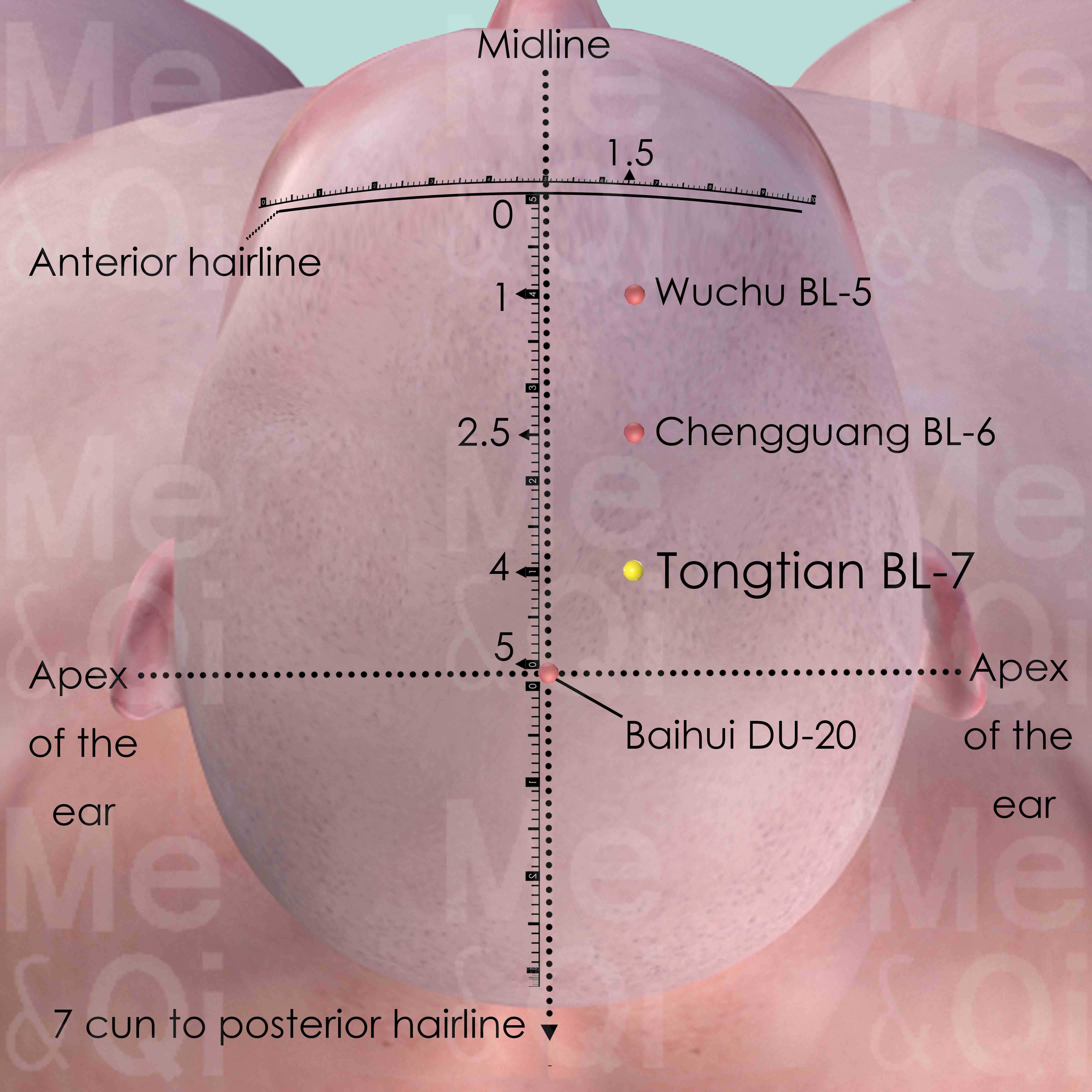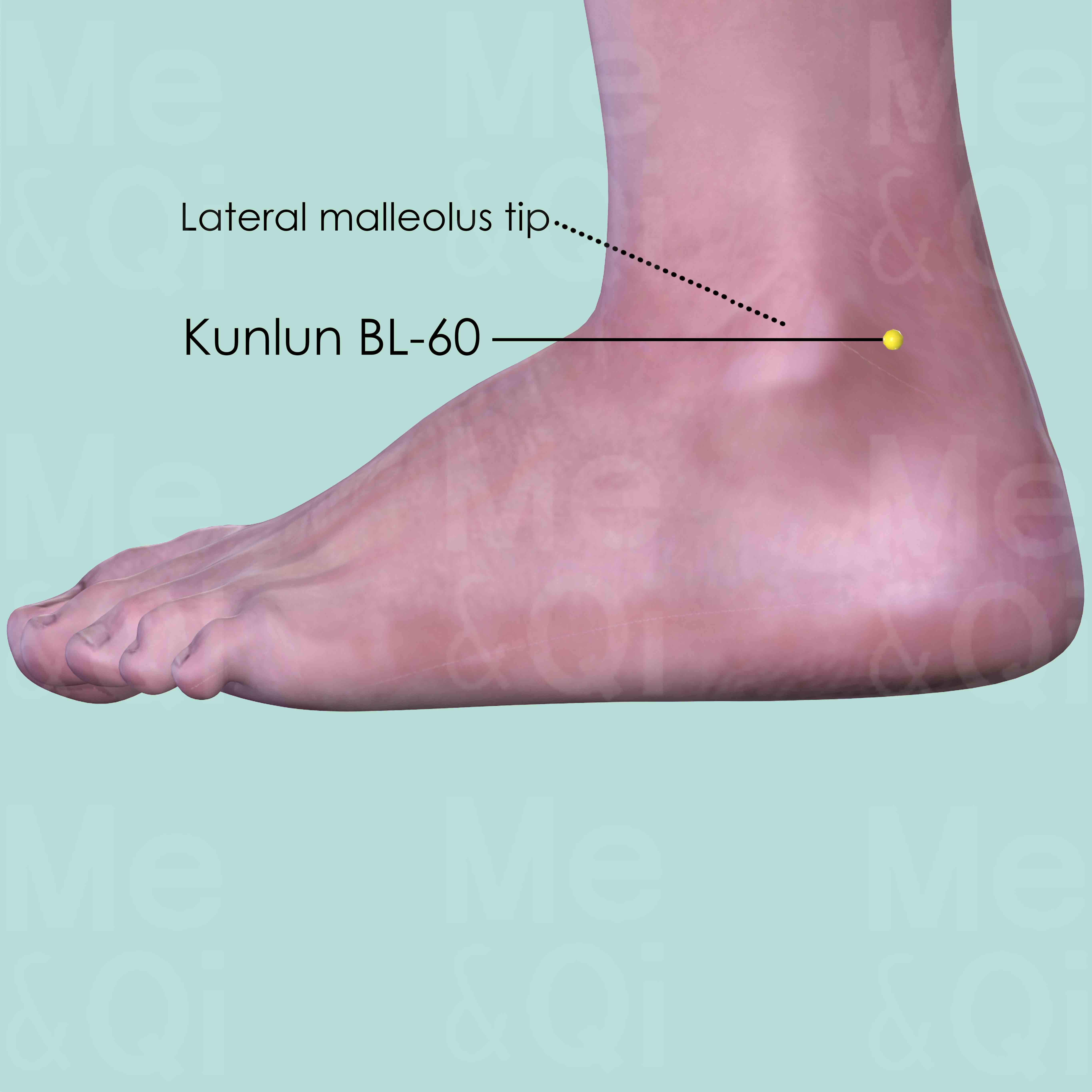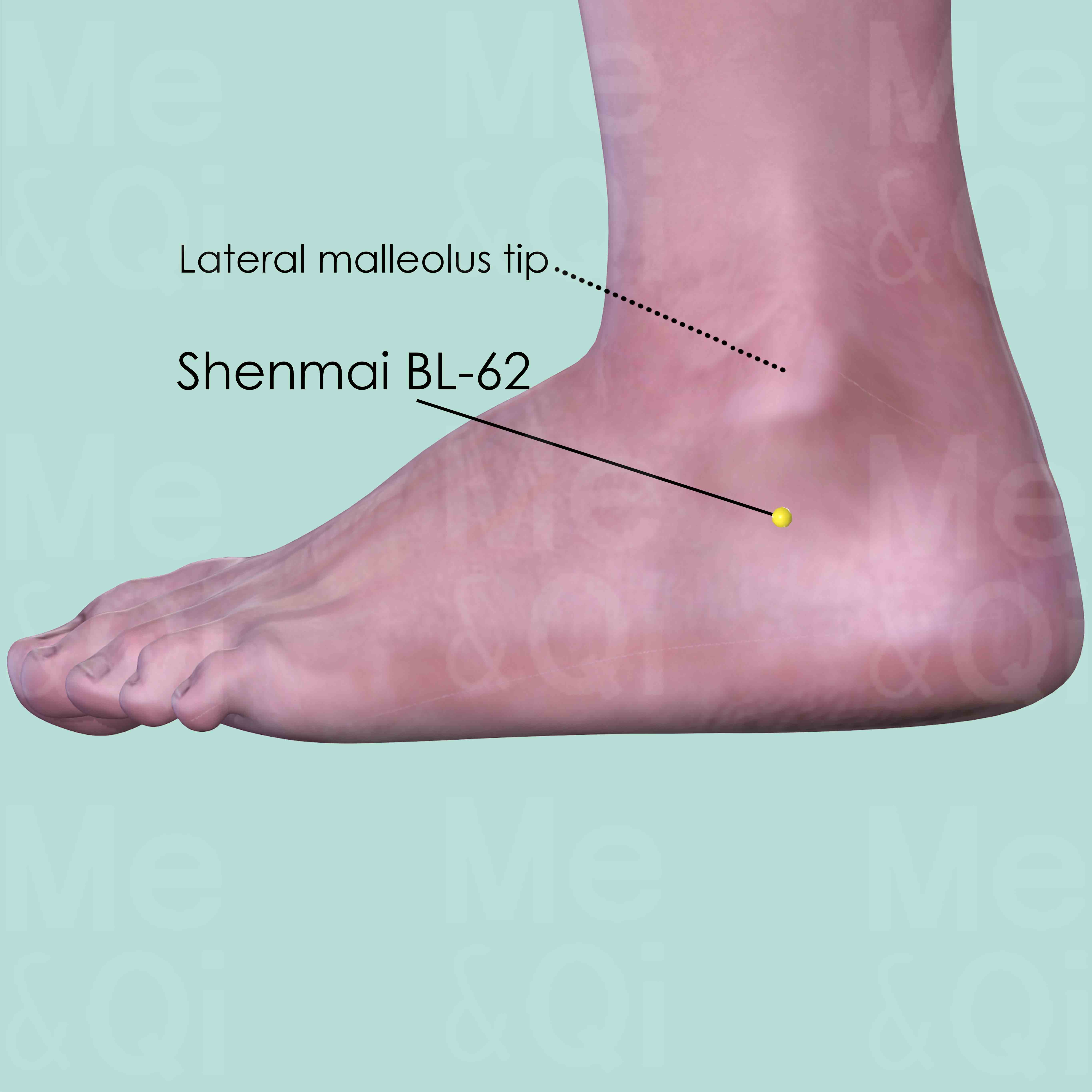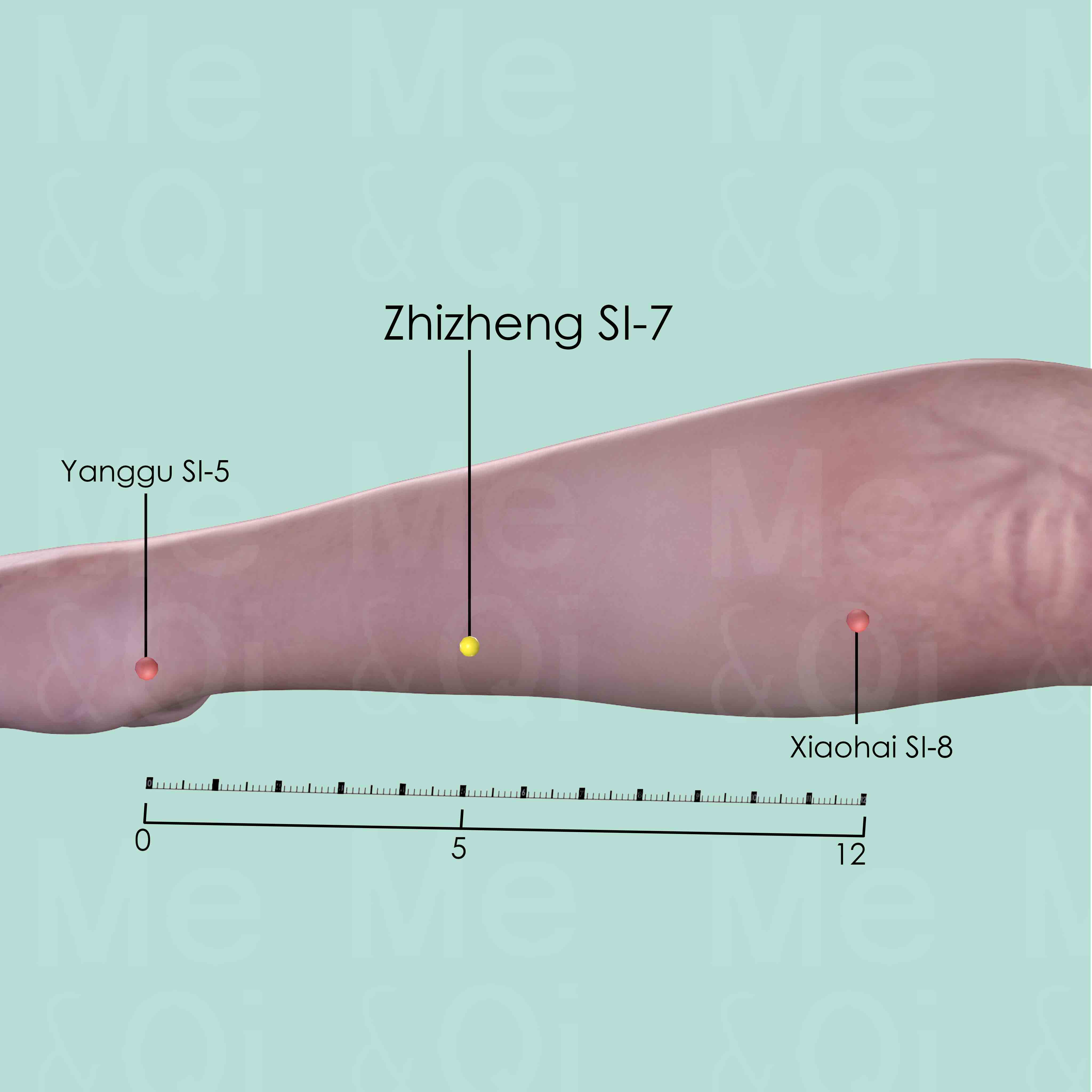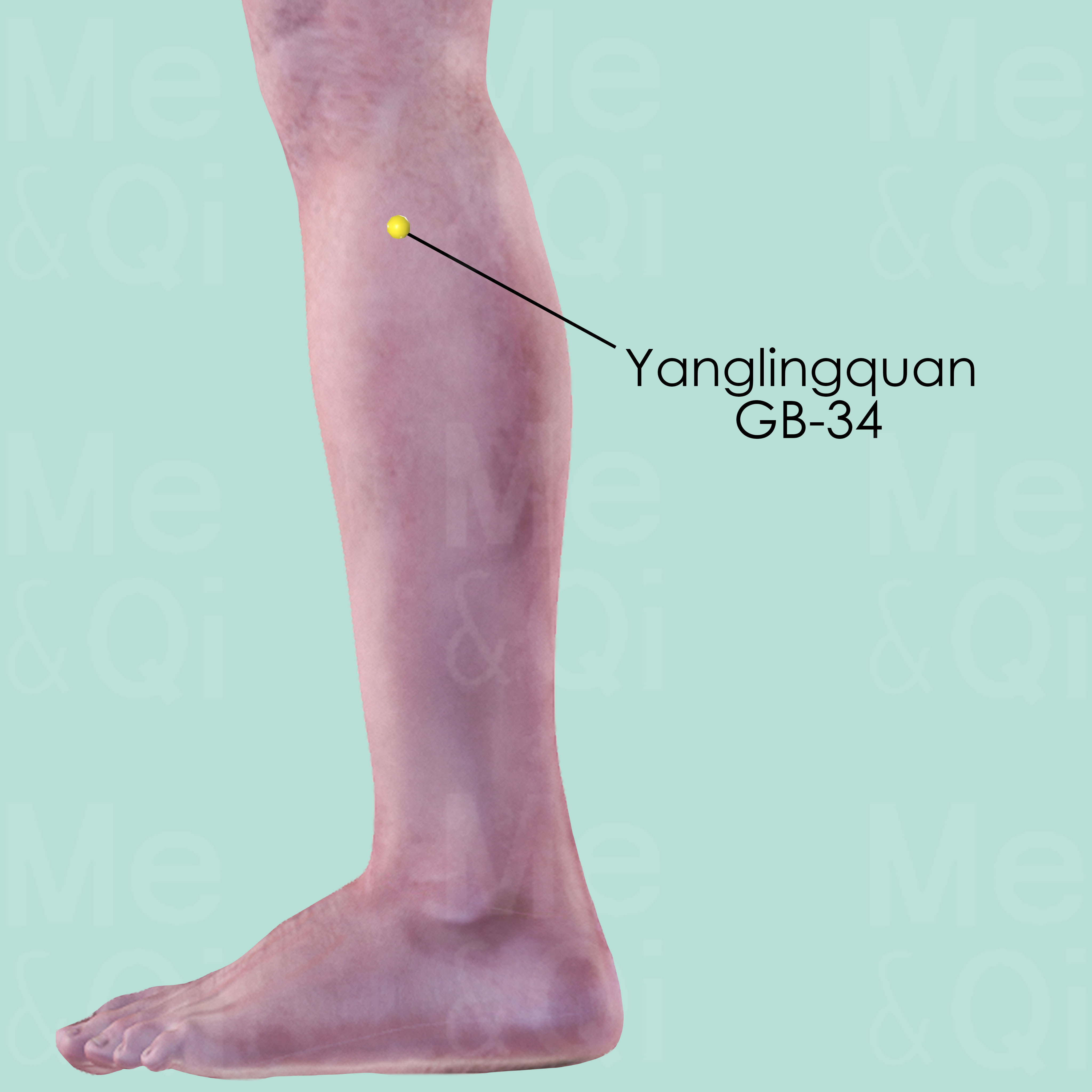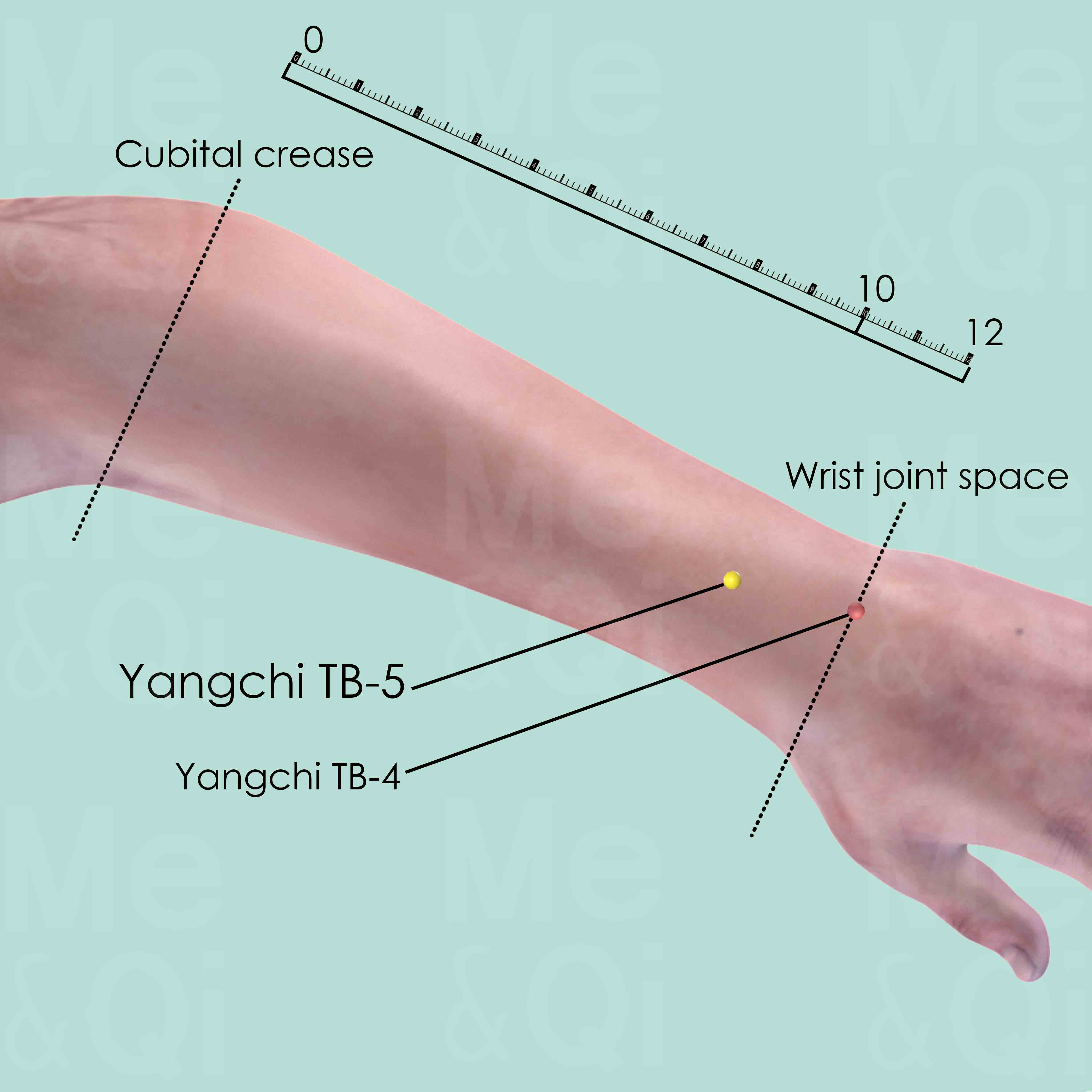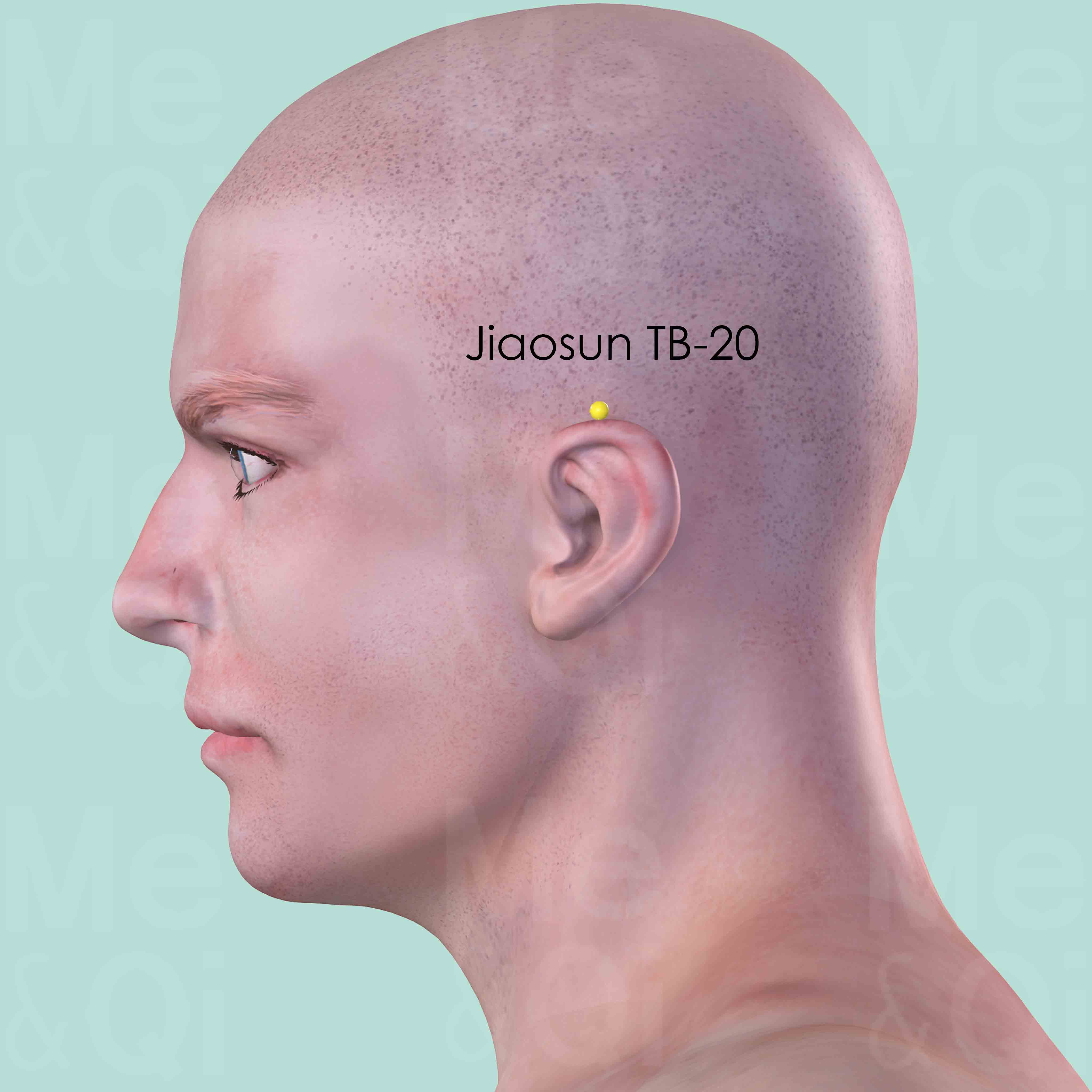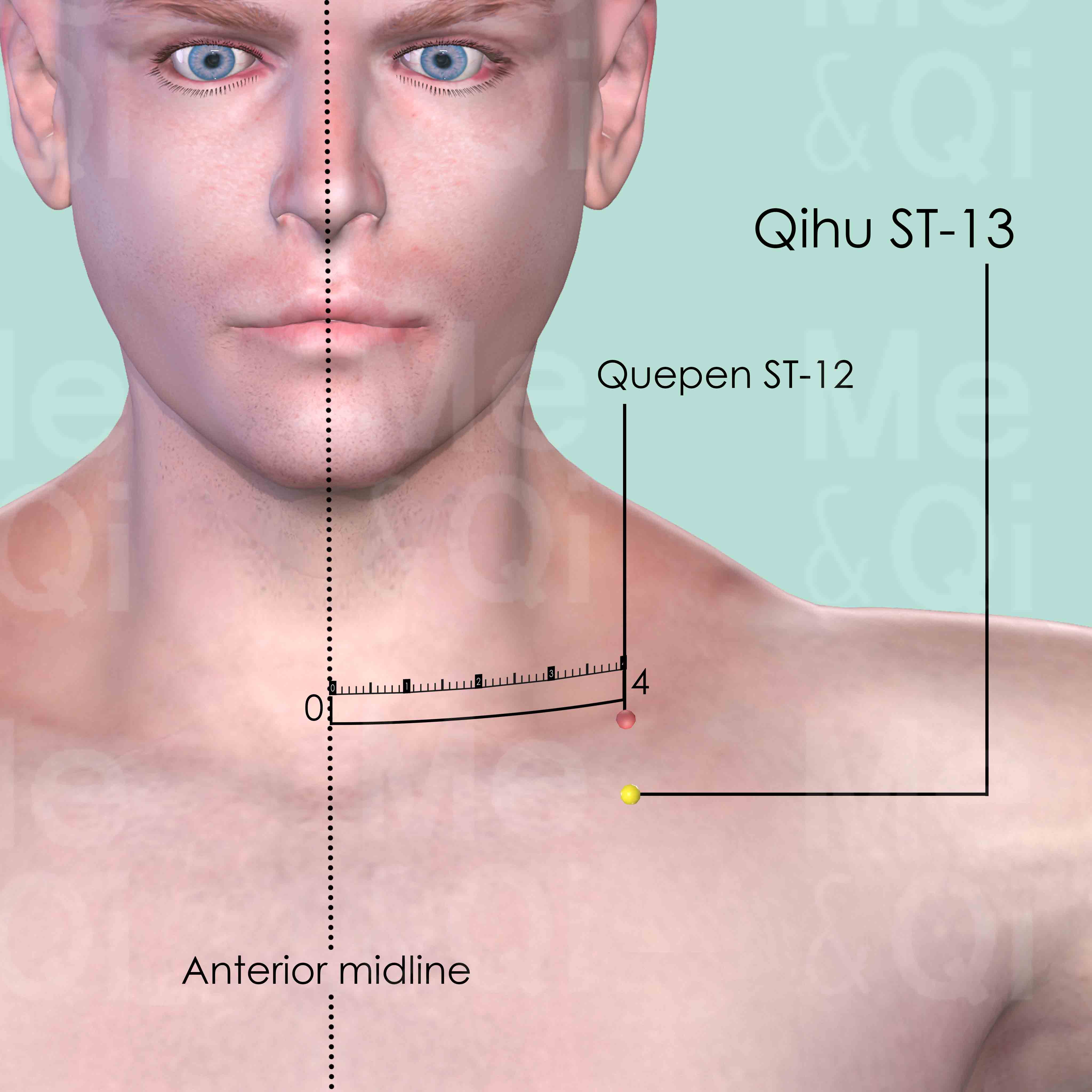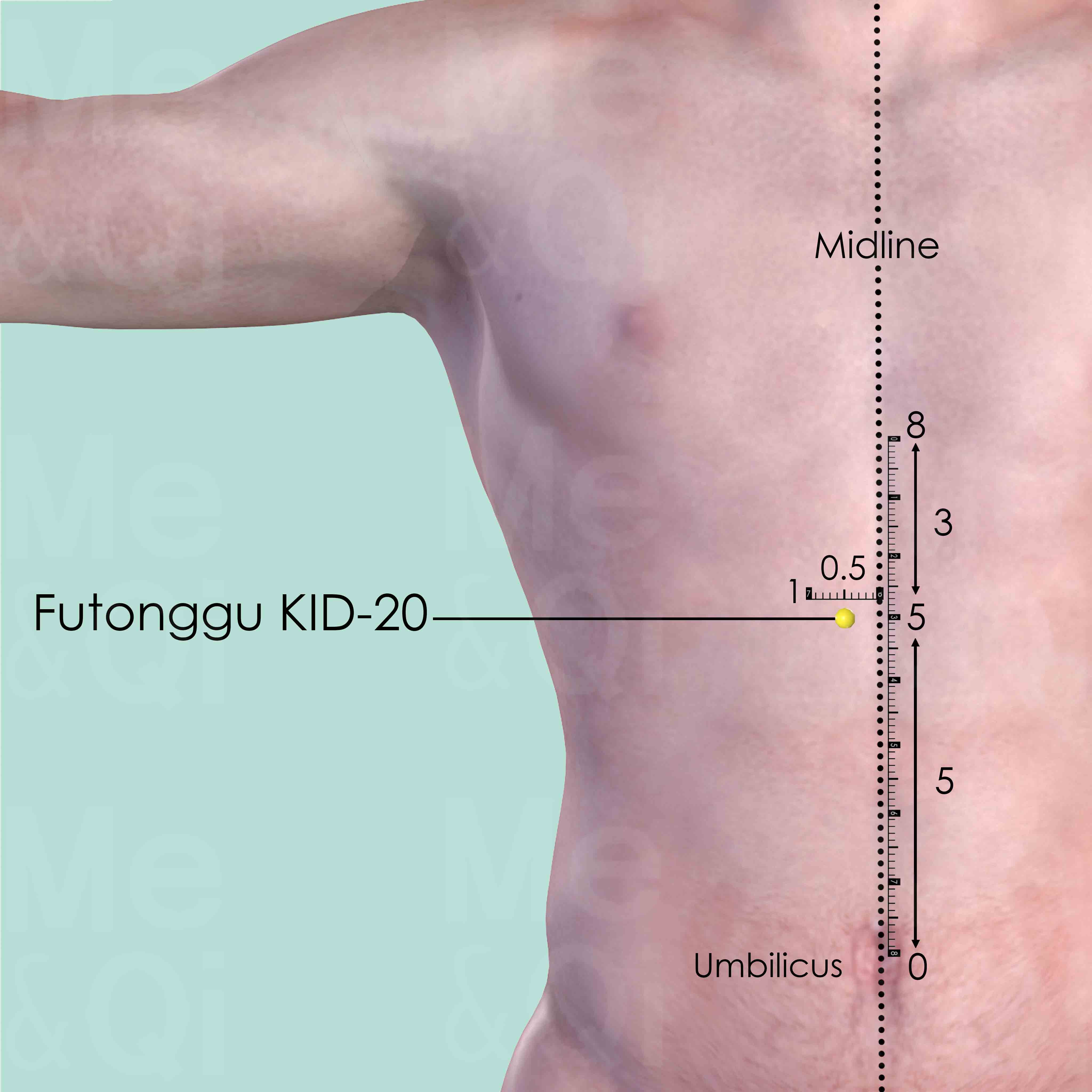Stiff Neckaccording to TCM
Symptom family: Back and Neck Stiffness and Discomfort
What is Stiff Neck?
A stiff neck, medically termed cervical rigidity, refers to a condition characterized by reduced mobility and discomfort in the neck area. This symptom involves a limitation in the range of motion, often accompanied by pain or discomfort when attempting to turn or tilt the head.
It's a common ailment that can arise from various causes, including muscle strain, prolonged awkward positioning, or underlying health issues.
How does TCM view Stiff Neck?
In Traditional Chinese Medicine (TCM), a stiff neck is seen as a disruption in the harmonious balance of the body's energies. TCM interprets this condition not just as a physical ailment but as a reflection of underlying imbalances in the flow of Qi (vital energy) and Blood.
According to TCM, the neck is a pivotal area where Qi and Blood circulate to connect the head and the body, and any disruption in this area can lead to stiffness. The holistic view of TCM also considers environmental, emotional, and lifestyle factors contributing to this condition.
Root Causes of Stiff Neck in TCM
TCM attributes stiff neck to several internal and external factors. Primarily, the invasion of external pathogenic factors like Wind, especially when combined with Cold or Dampness, is believed to obstruct the flow of Qi and Blood in the neck area.
Internally, emotional stress, anger, or frustration can lead to Liver Qi Stagnation, a common TCM diagnosis associated with muscle tension and stiffness.
Another cause considered in TCM is the Deficiency of Qi or Blood, leading to inadequate nourishment of neck muscles and tendons, resulting in stiffness. The treatment approach in TCM, therefore, involves identifying and addressing these specific patterns of imbalance.
Explore below more details about what might cause Stiff neck according to TCM.
Wind
In TCM "Wind" is a concept that represents a pattern of disharmony, often characterized by its sudden and unpredictable nature, much like a gusty wind changing direction without warning. This pattern is associated with symptoms that come and go quickly or move around the body, such as itching, tremors, or even certain types of pain. Wind is considered to be a primary cause of illnesses that have these rapidly changing characteristics. In TCM, external Wind often refers to illnesses that start suddenly, like the common cold, believed to be caused by external pathogenic factors like climatic changes. On the other hand, internal Wind can be linked to internal imbalances and can manifest in conditions like dizziness or spasms. ... see more
Wind Patterns That Can Lead to Stiff Neck
Common Symptoms: High Fever Convulsions Opisthotonos Headaches Anemophobia Sneezing Coughing Neck Pain
| Pattern Name | Relevant Symptoms | Relevant Formulas |
|---|---|---|
| Heat victorious stirring Wind | Rigidity of neck, High fever, Loss of consciousness, Limb twitching, Convulsions, Stiff neck, Opisthotonos, Eyeballs turning up, Clenching of teeth... see more | Ling Jiao Gou Teng Tang |
| Liver Wind agitating Internally due to extreme Heat | Rigidity of neck, High fever, Convulsions, Stiff neck, Hand tremor, Opisthotonos | Ling Jiao Gou Teng Tang | Tian Ma Gou Teng Yin | Feng Yin Tang |
| Exterior Wind | Stiff neck, Aversion to cold, Fever, Headaches, Anemophobia, Nasal discharge, Clear sputum, Itchy throat, Sneezing, Coughing, Muscle pain, Itchy skin... see more | Chuan Xiong Cha Tiao San |
| Greater Yang Attack of Wind | Stiff neck, Slight aversion to cold, Anemophobia, Low grade fever, Mild sweating, Sneezing, Occipital headache... see more | Gui Zhi Tang |
| Wind-Cold-Damp invading with Qi Deficiency | Stiff neck, High fever, Fever without perspiration, Headaches, Neck pain, Painful extremities, Focal distention, Chest distension, Congested nose, Noisy breathing, Coughing... see more | Ren Shen Bai Du San |
Cold
In TCM "Cold" as a pattern of disharmony refers to a specific type of imbalance within the body's systems, often linked to a deficiency or weakness. It's not about feeling physically cold or having a common cold, but rather a metaphorical description of certain symptoms and underlying conditions. When a TCM practitioner says someone suffers from "Cold," it usually implies that the body's Yang energy, which is warm and active, is insufficient or overpowered by Yin energy, which is cool and passive. Symptoms of Cold in TCM can include a general feeling of coldness, cold limbs, pale complexion, low energy, slow metabolism, and a preference for warmth. ... see more
Cold Patterns That Can Lead to Stiff Neck
Common Symptoms: Aversion To Cold Lack Of Sweating Arthralgia Joint Stiffness Muscle Pain Swollen Joints Muscle Numbness Fever
| Pattern Name | Relevant Symptoms | Relevant Formulas |
|---|---|---|
| Cold invading the Channels joints and muscles | Stiff neck, Arthralgia, Joint stiffness, Muscle pain, Swollen joints, Muscle numbness | Wu Tou Tang | Xiao Huo Luo Dan |
| Exterior-Cold | Stiff neck, Aversion to cold, Fever, Body pain, Lack of sweating, Absence of thirst, Feeling hot, Chills... see more | Ma Huang Tang | Gui Zhi Tang |
| Greater Yang Attack of Cold | Stiff neck, Occipital headache, Aversion to cold, Low grade fever, Lack of sweating, Sneezing, Nasal discharge, Shortness of breath... see more | Ma Huang Tang |
| Wind-Cold-Damp invading with Qi Deficiency | Stiff neck, High fever, Fever without perspiration, Headaches, Neck pain, Painful extremities, Focal distention, Chest distension, Congested nose, Noisy breathing, Coughing... see more | Ren Shen Bai Du San |
Heat
In TCM "Heat" signifies an excess of Yang energy, leading to an imbalance where heat predominates over the body's cool Yin aspects. This condition is metaphorically akin to an internal over-heating. Symptoms indicative of Heat can include feelings of warmth, fever, sweating, irritability, red face, thirst with a preference for cold drinks, and a rapid pulse. The tongue may appear red with a yellow coating. Unlike the common interpretation of heat in terms of temperature, in TCM, it represents a state of hyperactivity or inflammation in the body.... see more
Heat Patterns That Can Lead to Stiff Neck
Common Symptoms: High Fever Convulsions Opisthotonos Loss Of Consciousness Limb Twitching Eyeballs Turning Up Clenching Of Teeth Hand Tremor
| Pattern Name | Relevant Symptoms | Relevant Formulas |
|---|---|---|
| Heat victorious stirring Wind | Rigidity of neck, High fever, Loss of consciousness, Limb twitching, Convulsions, Stiff neck, Opisthotonos, Eyeballs turning up, Clenching of teeth... see more | Ling Jiao Gou Teng Tang |
| Liver Wind agitating Internally due to extreme Heat | Rigidity of neck, High fever, Convulsions, Stiff neck, Hand tremor, Opisthotonos | Ling Jiao Gou Teng Tang | Tian Ma Gou Teng Yin | Feng Yin Tang |
| Exterior-Heat | Stiff neck, Aversion to cold, Fever, Perspiration, Thirst, Body pain | Yin Qiao San | Shi Gao Tang |
Yang Excess
Yang Excess in TCM refers to a state where there is an overabundance of Yang energy, leading to symptoms of heat and hyperactivity in the body. This pattern of disharmony often arises from factors like stress, excessive physical activity, overconsumption of spicy or heating foods, or an internal imbalance that causes Yang to flare up. Symptoms of Yang Excess include a feeling of heat, red face, irritability, restlessness, thirst, constipation, and a rapid, forceful pulse. Treatment in TCM for Yang Excess aims to cool down and subdue the excessive Yang while nurturing Yin energy to restore balance.... see more
Yang Excess Patterns That Can Lead to Stiff Neck
| Pattern Name | Relevant Symptoms | Relevant Formulas |
|---|---|---|
| Liver Yang Rising | Stiff neck, Headaches, Dizziness, Tinnitus, Deafness, Blurry vision, Dry mouth, Dry throat, Insomnia, Irritability, Exhaustion, Anger, Shoulder stiffness, Stiff upper back... see more | Ling Jiao Gou Teng Tang | Tian Ma Gou Teng Yin | Liu Wei Di Huang Wan | Qi Ju Di Huang Wan | Da Chai Hu Tang | Zhen Zhu Mu Wan | Zhen Xin An Shen Tang |
Qi Deficiency
Qi Deficiency in TCM is like running low on battery power. Qi is the vital energy that powers every function in your body. When there's a Qi Deficiency, it means your body doesn't have enough of this essential energy. This can make you feel tired all the time, weak, or even cause shortness of breath. It's similar to how you feel when you haven't had enough sleep or nutritious food. Your body just doesn't have the energy it needs to perform at its best. Unlike modern medicine, which often focuses on specific physical causes for fatigue and weakness, TCM views Qi Deficiency as an overall energy depletion that affects your entire well-being, and it seeks to replenish and balance this vital energy.... see more
Qi Deficiency Patterns That Can Lead to Stiff Neck
| Pattern Name | Relevant Symptoms | Relevant Formulas |
|---|---|---|
| Wind-Cold-Damp invading with Qi Deficiency | Stiff neck, High fever, Fever without perspiration, Headaches, Neck pain, Painful extremities, Focal distention, Chest distension, Congested nose, Noisy breathing, Coughing... see more | Ren Shen Bai Du San |
Dampness
"Dampness" in TCM is a concept that describes a pattern of disharmony where the body accumulates excess moisture. Imagine the heavy, sticky feeling you get on a very humid day; that's similar to what dampness feels like internally. It can manifest as a sense of heaviness, bloating, sluggishness, or even a foggy mind. This condition is often thought to arise from environmental factors like living in a damp place, dietary habits that promote moisture in the body, or internal imbalances that hinder the body's ability to process fluids properly. In TCM, dampness can obstruct the normal flow of energy and fluids in the body, leading to various symptoms.... see more
Dampness Patterns That Can Lead to Stiff Neck
| Pattern Name | Relevant Symptoms | Relevant Formulas |
|---|---|---|
| Wind-Cold-Damp invading with Qi Deficiency | Stiff neck, High fever, Fever without perspiration, Headaches, Neck pain, Painful extremities, Focal distention, Chest distension, Congested nose, Noisy breathing, Coughing... see more | Ren Shen Bai Du San |
Liver
In TCM the Liver is viewed as the organ responsible for the smooth flow of Qi, Blood, and emotions throughout the body. It plays a key role in regulating mood, storing blood, supporting digestion, and ensuring the health of tendons and eyes. When the Liver malfunctions or is imbalanced in TCM, it can lead to a range of issues such as irritability, mood swings, menstrual irregularities, eye problems, and muscular stiffness or pain. A malfunctioning Liver in TCM reflects not only physical disturbances but also emotional and mental disharmony, emphasizing the holistic approach of TCM in addressing health and wellness.... see more
Liver Patterns That Can Lead to Stiff Neck
Common Symptoms: High Fever Convulsions Opisthotonos Dizziness Loss Of Consciousness Limb Twitching Eyeballs Turning Up Clenching Of Teeth
| Pattern Name | Relevant Symptoms | Relevant Formulas |
|---|---|---|
| Heat victorious stirring Wind | Rigidity of neck, High fever, Loss of consciousness, Limb twitching, Convulsions, Stiff neck, Opisthotonos, Eyeballs turning up, Clenching of teeth... see more | Ling Jiao Gou Teng Tang |
| Liver Wind agitating Internally due to extreme Heat | Rigidity of neck, High fever, Convulsions, Stiff neck, Hand tremor, Opisthotonos | Ling Jiao Gou Teng Tang | Tian Ma Gou Teng Yin | Feng Yin Tang |
| Liver Yang Rising | Stiff neck, Headaches, Dizziness, Tinnitus, Deafness, Blurry vision, Dry mouth, Dry throat, Insomnia, Irritability, Exhaustion, Anger, Shoulder stiffness, Stiff upper back... see more | Ling Jiao Gou Teng Tang | Tian Ma Gou Teng Yin | Liu Wei Di Huang Wan | Qi Ju Di Huang Wan | Da Chai Hu Tang | Zhen Zhu Mu Wan | Zhen Xin An Shen Tang |
TCM Herbal Formulas for Stiff Neck
TCM employs various herbal formulas to address stiff neck, depending on the underlying cause. Formulas like Ling Jiao Gou Teng Tang are used to pacify Internal Liver Wind and stop tremors, particularly effective when Wind-Heat cause stiffness.
In cases of Cold invasion causing neck stiffness, formulas such as Ma Huang Tang, which clear Wind-Cold, are prescribed. These formulas are selected based on individual diagnosis and pattern differentiation in TCM, emphasizing a personalized approach to treatment.
Explore below some TCM herbal formulas used to address stiff neck, organized by cause and by formula type.
- By Cause
- By Formula Type
- Wind
- Cold
- Heat
- Yang Excess
- Qi Deficiency
- Dampness
- View More Causes
- Formulas that dredge and disperse external wind
- Formulas that pacify and extinguish internal wind
- Formulas that clear wind-Cold
- External formulas for external disorders
- Formulas that nourish yin and tonify
- Formulas that warm the meridians and disperse cold
- Formulas that release the exterior and clear the interior
- Formulas that release the exterior and purge the interior
- Formulas that sedate and calm the mind
- Formulas that nourish the heart and calm the mind
- Formulas that dispel wind-Damp
Top Formula for Wind:
Ling Jiao Gou Teng Tang
Suitable for Wind patterns that may cause stiff neck, such as Heat victorious stirring Wind or Liver Wind agitating Internally due to extreme Heat
Learn moreAll Formulas Recommended for Stiff Neck Caused by Wind
| Formula | Patterns Suitable For |
|---|---|
| Ling Jiao Gou Teng Tang | Heat victorious stirring Wind, Liver Wind agitating Internally due to extreme Heat... see more |
| Tian Ma Gou Teng Yin | Liver Wind agitating Internally due to extreme Heat |
| Gui Zhi Tang | Greater Yang Attack of Wind |
| Feng Yin Tang | Liver Wind agitating Internally due to extreme Heat |
| Chuan Xiong Cha Tiao San | Exterior Wind |
| Ren Shen Bai Du San | Wind-Cold-Damp invading with Qi Deficiency |
Top Formula for Cold:
Ma Huang Tang
Suitable for Cold patterns that may cause stiff neck, such as Exterior-Cold or Greater Yang Attack of Cold
Learn moreAll Formulas Recommended for Stiff Neck Caused by Cold
| Formula | Patterns Suitable For |
|---|---|
| Ma Huang Tang | Exterior-Cold, Greater Yang Attack of Cold |
| Wu Tou Tang | Cold invading the Channels joints and muscles |
| Xiao Huo Luo Dan | Cold invading the Channels joints and muscles |
| Gui Zhi Tang | Exterior-Cold |
| Ren Shen Bai Du San | Wind-Cold-Damp invading with Qi Deficiency |
Top Formula for Heat:
Ling Jiao Gou Teng Tang
Suitable for Heat patterns that may cause stiff neck, such as Heat victorious stirring Wind or Liver Wind agitating Internally due to extreme Heat
Learn moreAll Formulas Recommended for Stiff Neck Caused by Heat
| Formula | Patterns Suitable For |
|---|---|
| Ling Jiao Gou Teng Tang | Heat victorious stirring Wind, Liver Wind agitating Internally due to extreme Heat... see more |
| Tian Ma Gou Teng Yin | Liver Wind agitating Internally due to extreme Heat |
| Feng Yin Tang | Liver Wind agitating Internally due to extreme Heat |
| Yin Qiao San | Exterior-Heat |
| Shi Gao Tang | Exterior-Heat |
Top Formula for Yang Excess:
Ling Jiao Gou Teng Tang
Suitable for Yang Excess patterns that may cause stiff neck, such as Liver Yang Rising
Learn moreAll Formulas Recommended for Stiff Neck Caused by Yang Excess
| Formula | Patterns Suitable For |
|---|---|
| Ling Jiao Gou Teng Tang | Liver Yang Rising |
| Tian Ma Gou Teng Yin | Liver Yang Rising |
| Liu Wei Di Huang Wan | Liver Yang Rising |
| Qi Ju Di Huang Wan | Liver Yang Rising |
| Da Chai Hu Tang | Liver Yang Rising |
| Zhen Zhu Mu Wan | Liver Yang Rising |
| Zhen Xin An Shen Tang | Liver Yang Rising |
Top Formula for Qi Deficiency:
Ren Shen Bai Du San
Suitable for Qi Deficiency patterns that may cause stiff neck, such as Wind-Cold-Damp invading with Qi Deficiency
Learn moreTop Formula for Dampness:
Ren Shen Bai Du San
Suitable for Dampness patterns that may cause stiff neck, such as Wind-Cold-Damp invading with Qi Deficiency
Learn moreFormulas that dredge and disperse External Wind
These formulas are suitable for some stiff neck-causing patterns like Cold invading the Channels joints and muscles or Painful Obstruction.
One such formula is Xiao Huo Luo Dan, with prepared kusnezoffii aconite as a key herb.
Other formulas of this category are listed in the table below.
All "formulas that dredge and disperse external wind" recommended for stiff neck
| Formula | Patterns Suitable For (if applicable) |
|---|---|
| Xiao Huo Luo Dan | Cold invading the Channels joints and muscles, Painful Obstruction |
| Feng Yin Tang | Liver Wind agitating Internally due to extreme Heat |
| Chuan Xiong Cha Tiao San | Exterior Wind |
Formulas that pacify and extinguish Internal Wind
These formulas are suitable for some stiff neck-causing patterns like Heat victorious stirring Wind or Liver Wind agitating Internally due to extreme Heat.
One such formula is Ling Jiao Gou Teng Tang, with saiga antelope's horns as a key herb.
Other formulas of this category are listed in the table below.
All "formulas that pacify and extinguish internal wind" recommended for stiff neck
| Formula | Patterns Suitable For (if applicable) |
|---|---|
| Ling Jiao Gou Teng Tang | Heat victorious stirring Wind, Liver Wind agitating Internally due to extreme Heat, Liver Yang Rising... see more |
| Tian Ma Gou Teng Yin | Liver Wind agitating Internally due to extreme Heat, Liver Yang Rising |
Formulas that clear Wind-Cold
These formulas are suitable for some stiff neck-causing patterns like Exterior-Cold or Greater Yang Attack of Cold.
One such formula is Ma Huang Tang, with ephedra as a key herb.
Other formulas of this category are listed in the table below.
All "formulas that clear wind-Cold" recommended for stiff neck
| Formula | Patterns Suitable For (if applicable) |
|---|---|
| Ma Huang Tang | Exterior-Cold, Greater Yang Attack of Cold |
| Gui Zhi Tang | Exterior-Cold, Greater Yang Attack of Wind |
External formulas for External disorders
These formulas are suitable for some stiff neck-causing patterns like Exterior-Heat.
One such formula is Yin Qiao San, with honeysuckle flowers as a key herb.
Other formulas of this category are listed in the table below.
All "external formulas for external disorders" recommended for stiff neck
| Formula | Patterns Suitable For (if applicable) |
|---|---|
| Yin Qiao San | Exterior-Heat |
| Ren Shen Bai Du San | Wind-Cold-Damp invading with Qi Deficiency |
Formulas that warm the Meridians and disperse Cold
These formulas are suitable for some stiff neck-causing patterns like Cold invading the Channels joints and muscles or Painful Obstruction.
One such formula is Wu Tou Tang, with prepared sichuan aconite as a key herb.
Formulas that nourish Yin and tonify
These formulas are suitable for some stiff neck-causing patterns like Liver Yang Rising.
One such formula is Liu Wei Di Huang Wan, with prepared rehmannia as a key herb.
Other formulas of this category are listed in the table below.
All "formulas that nourish yin and tonify" recommended for stiff neck
| Formula | Patterns Suitable For (if applicable) |
|---|---|
| Liu Wei Di Huang Wan | Liver Yang Rising |
| Qi Ju Di Huang Wan | Liver Yang Rising |
Formulas that Release the Exterior and Clear the Interior
These formulas are suitable for some stiff neck-causing patterns like Exterior-Heat.
One such formula is Shi Gao Tang, with gypsum as a key herb.
Formulas that release the Exterior and purge the Interior
These formulas are suitable for some stiff neck-causing patterns like Liver Yang Rising.
One such formula is Da Chai Hu Tang, with bupleurum root as a key herb.
Formulas that sedate and calm the Mind
These formulas are suitable for some stiff neck-causing patterns like Liver Yang Rising.
One such formula is Zhen Zhu Mu Wan, with mother of pearl as a key herb.
Formulas that nourish the Heart and calm the Mind
These formulas are suitable for some stiff neck-causing patterns like Liver Yang Rising.
One such formula is Zhen Xin An Shen Tang
Formulas that dispel Wind-Damp
These formulas are suitable for some stiff neck-causing patterns like Painful Obstruction.
One such formula is Da Fang Feng Tang, with saposhnikovia root as a key herb.
Acupoints for Stiff Neck
TCM acupuncture involves specific acupoints for treating stiff neck. Points such as Dazhu BL-11 and Fengmen BL-12 on the Bladder Channel are targeted for their effectiveness in expelling wind and nourishing Blood, crucial for alleviating neck stiffness. Ganshu BL-18 is also used for invigorating Liver Qi and Blood, which can be beneficial in cases where Liver disharmony contributes to neck rigidity.
Additionally, points on the Small Intestine and Triple Burner Channels, such as Bingfeng SI-12 and Jianjing GB-21, are selected to open channels and remove obstructions, promoting relief from stiffness. These acupoints are chosen based on their specific actions and relevance to the diagnosed pattern in TCM.
Explore below some acupoints used to address stiff neck, organized by meridian.
- By Meridian
- Bladder Channel
- Small Intestine Channel
- Gall Bladder Channel
- Triple Burner Channel
- Governing Vessel
- Stomach Channel
- Extra Points: Head and Neck (EX-HN)
- Large Intestine Channel
- Kidney Channel
- Lung Channel
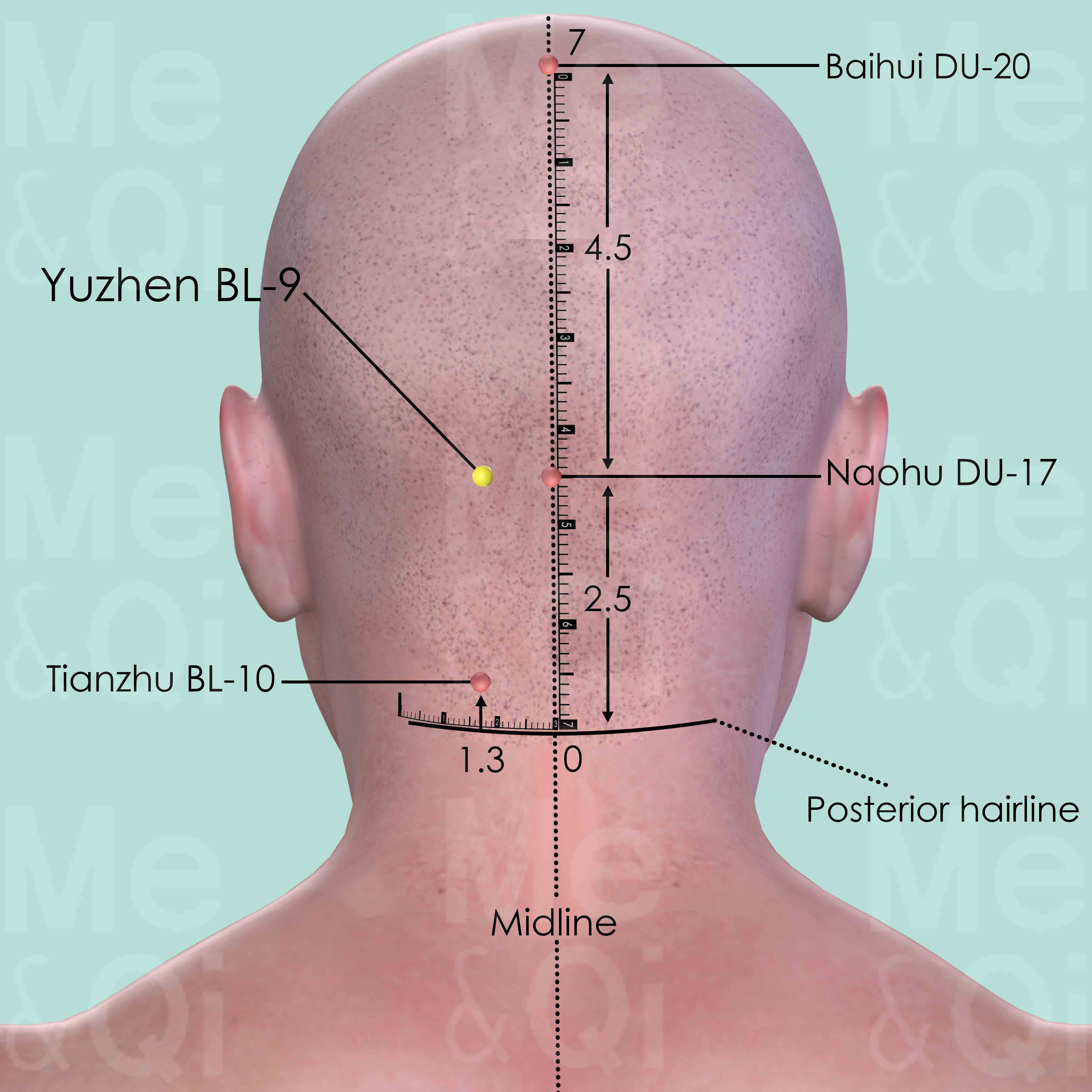
Yuzhen BL-9
First identify Naohu DU-17 which is on the superior border of the external occipital protuberance. Yuzhen BL-9 is 1.3 cun lateral to Naohu DU-17.
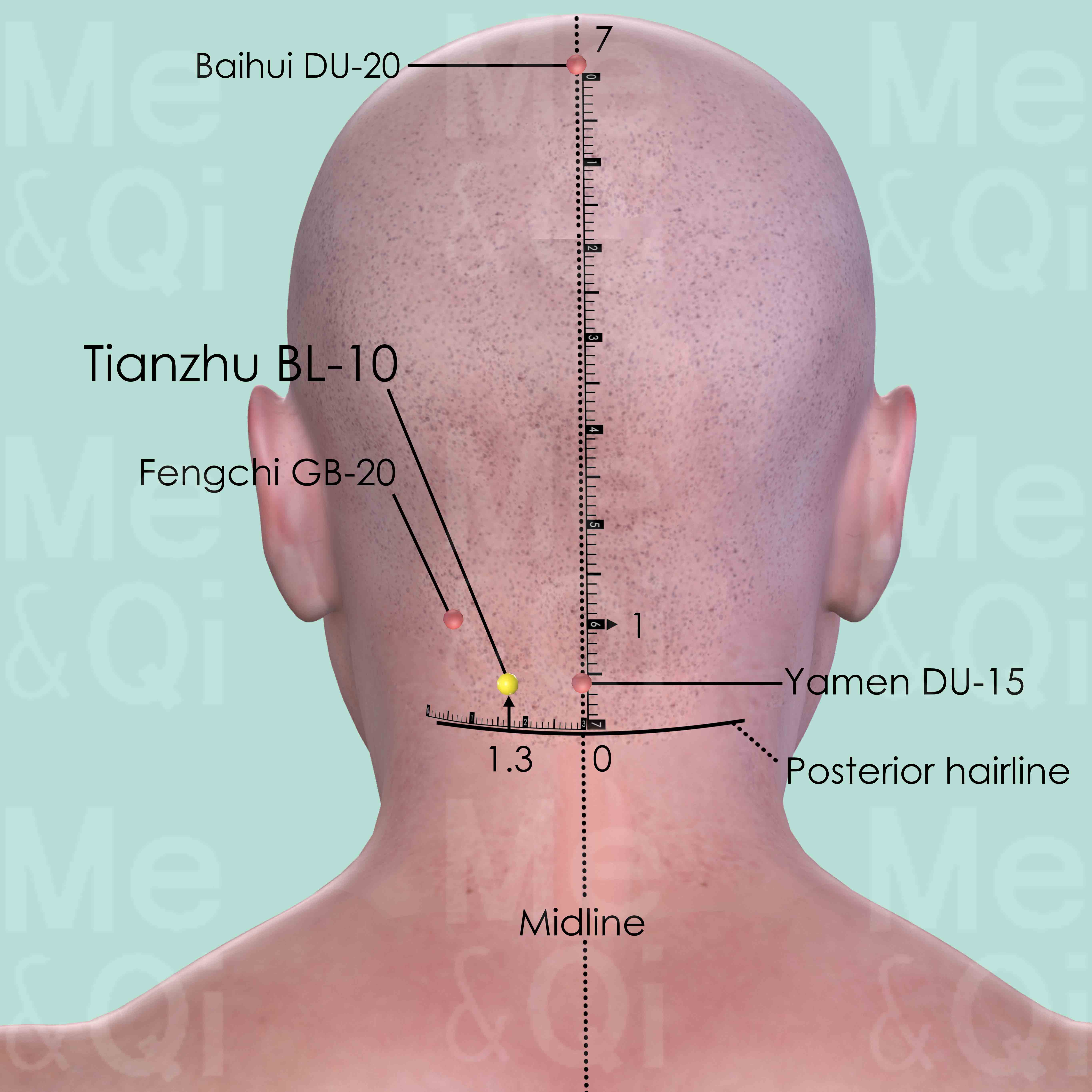
Tianzhu BL-10
1.3 cun lateral to Yamen DU-15 on the posterior midline, 0.5 cun above the posterior hairline, on the lateral side of trapezius muscle.
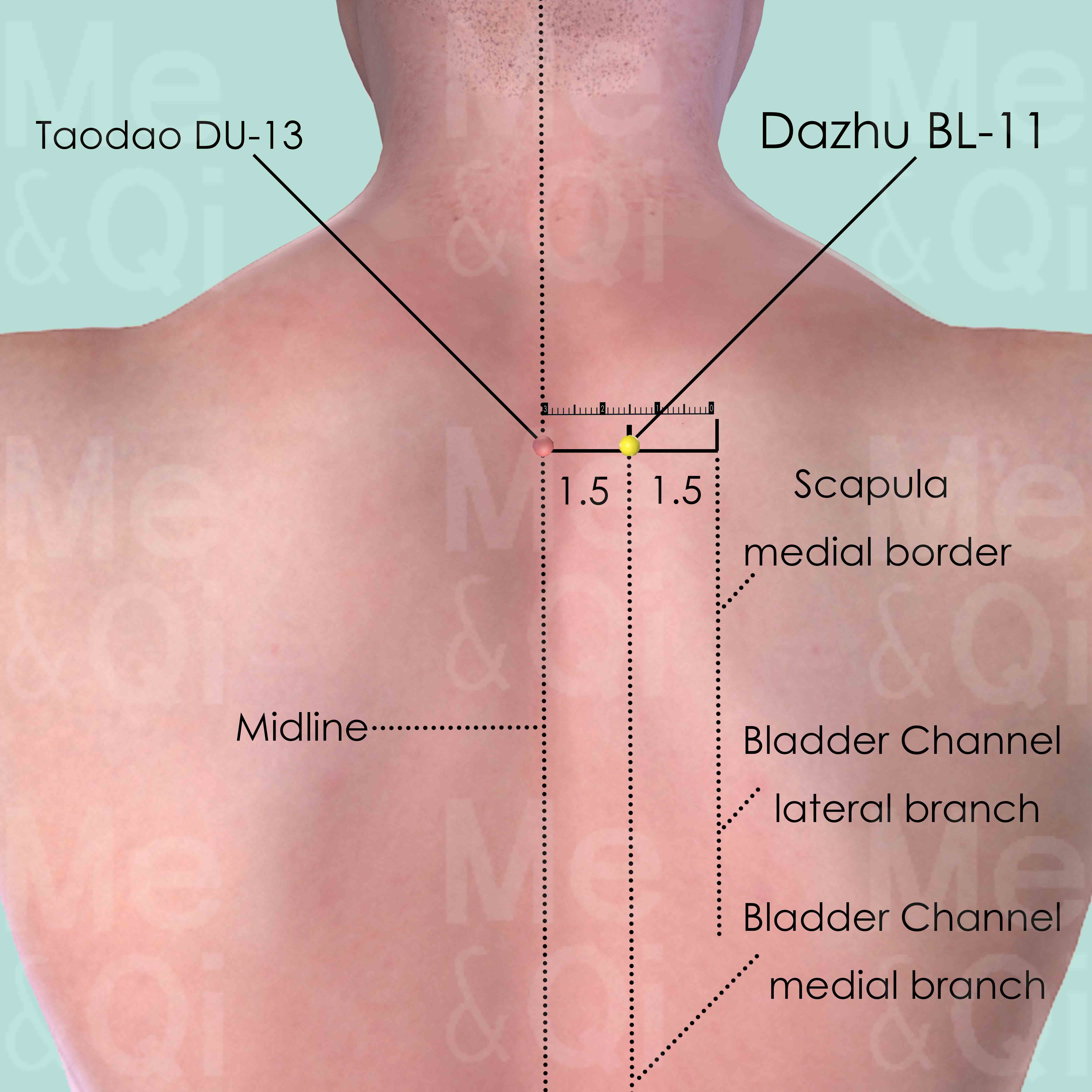
Dazhu BL-11
On the level of the lower border of the spinous process of the 1st thoracic vertebra (T1), 1.5 cun (about 2 finger-breadths) lateral to the posterior midline.
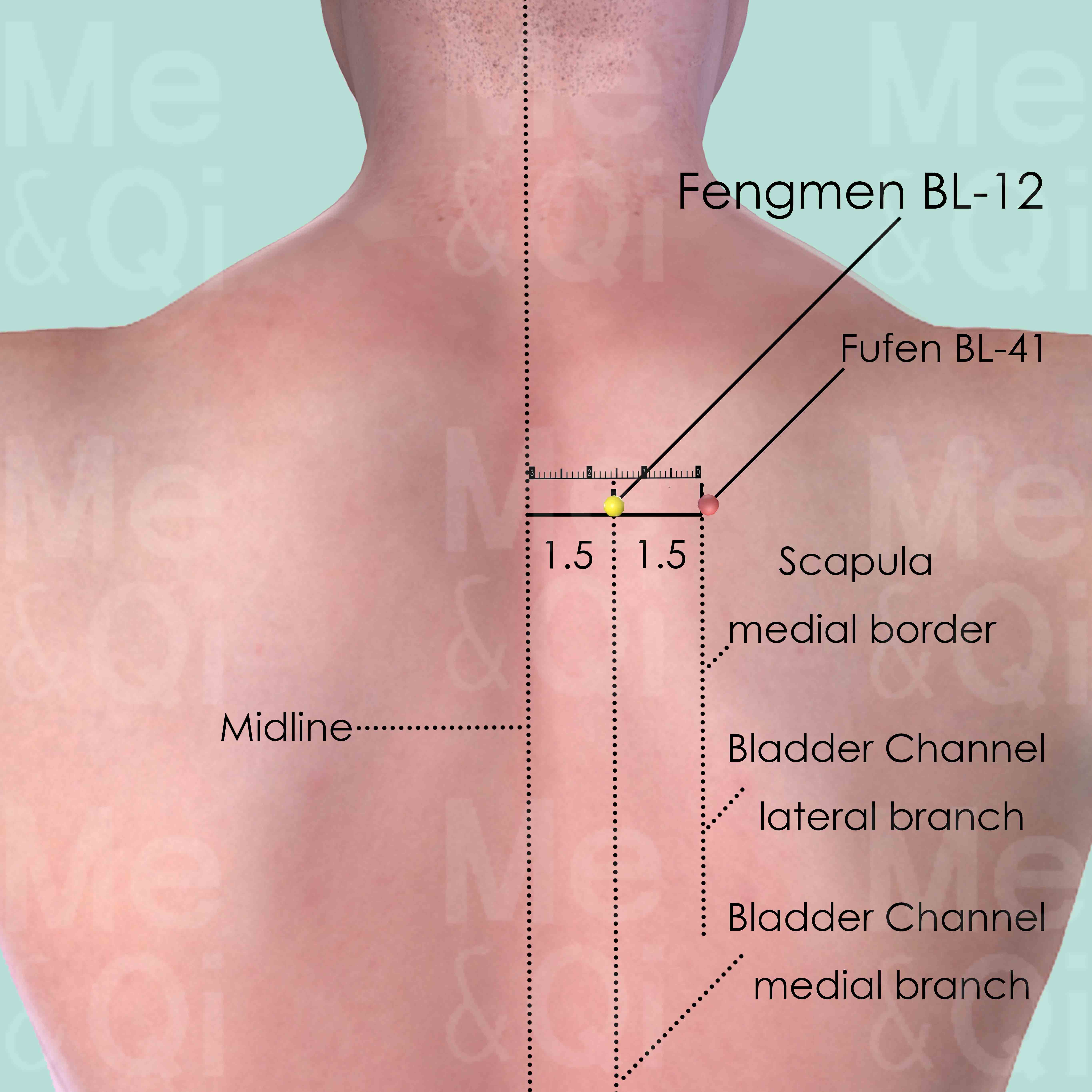
Fengmen BL-12
1.5 cun lateral to the lower border of the spinous process of the 2nd thoracic vertebra (T2).
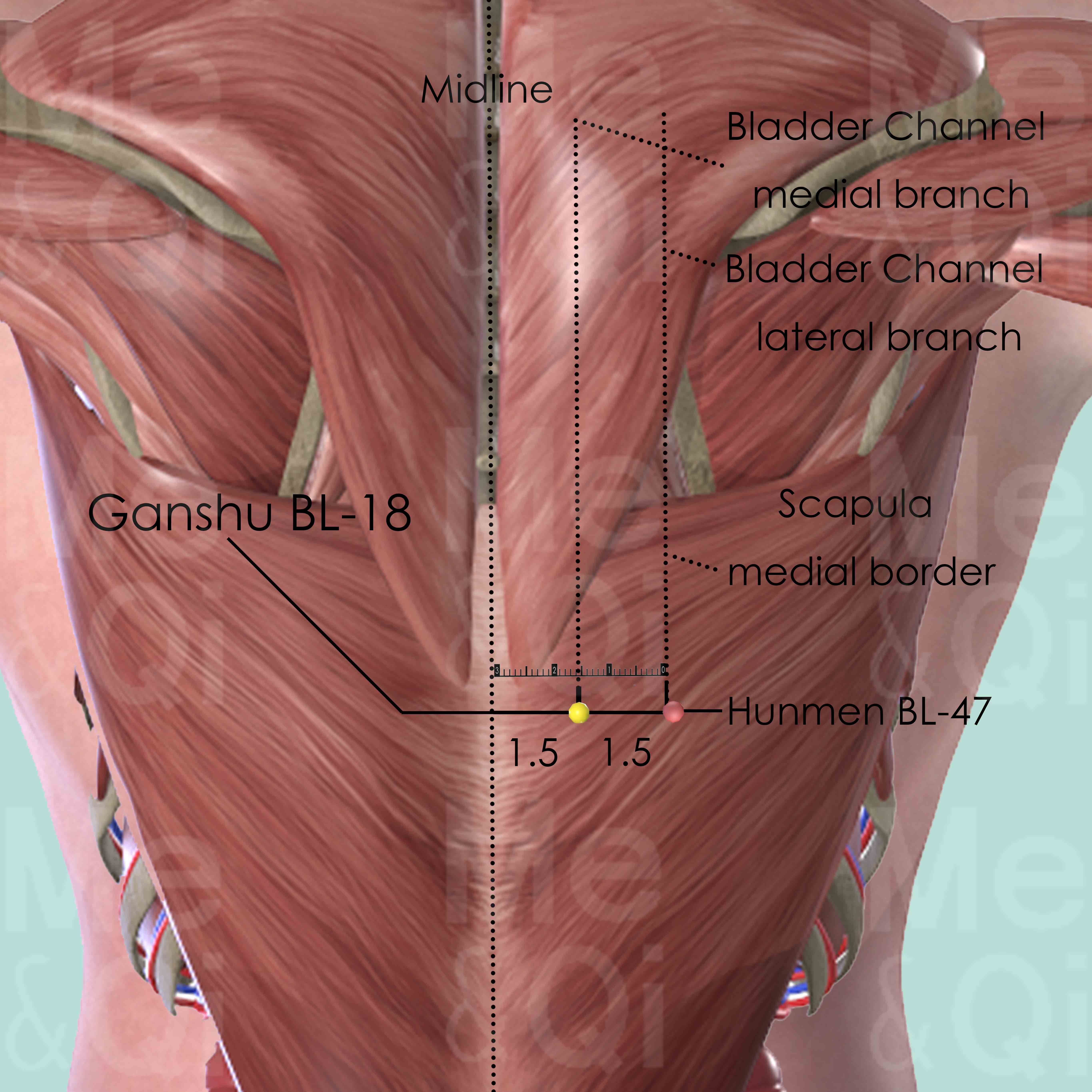
Ganshu BL-18
1.5 cun lateral to the lower border of the spinous process of the 9th thoracic vertebra (T9).
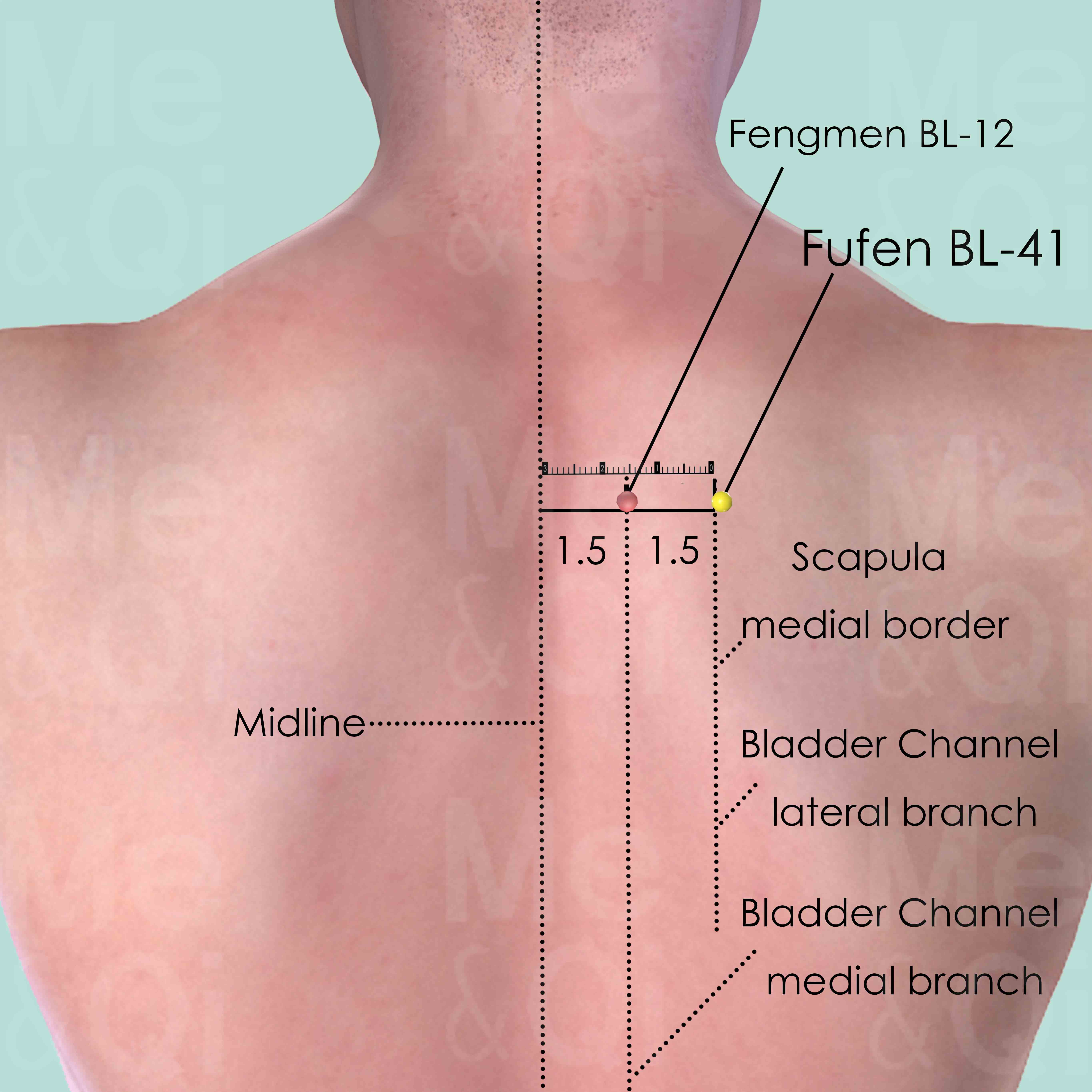
Fufen BL-41
3 cun (about 4 finger-breadths) lateral to the lower border of the spinous process of the 2nd thoracic vertebra (T2).

Shaoze SI-1
On the ulnar side of the little finger, about 0.1 cun posterior to the corner of the nail.
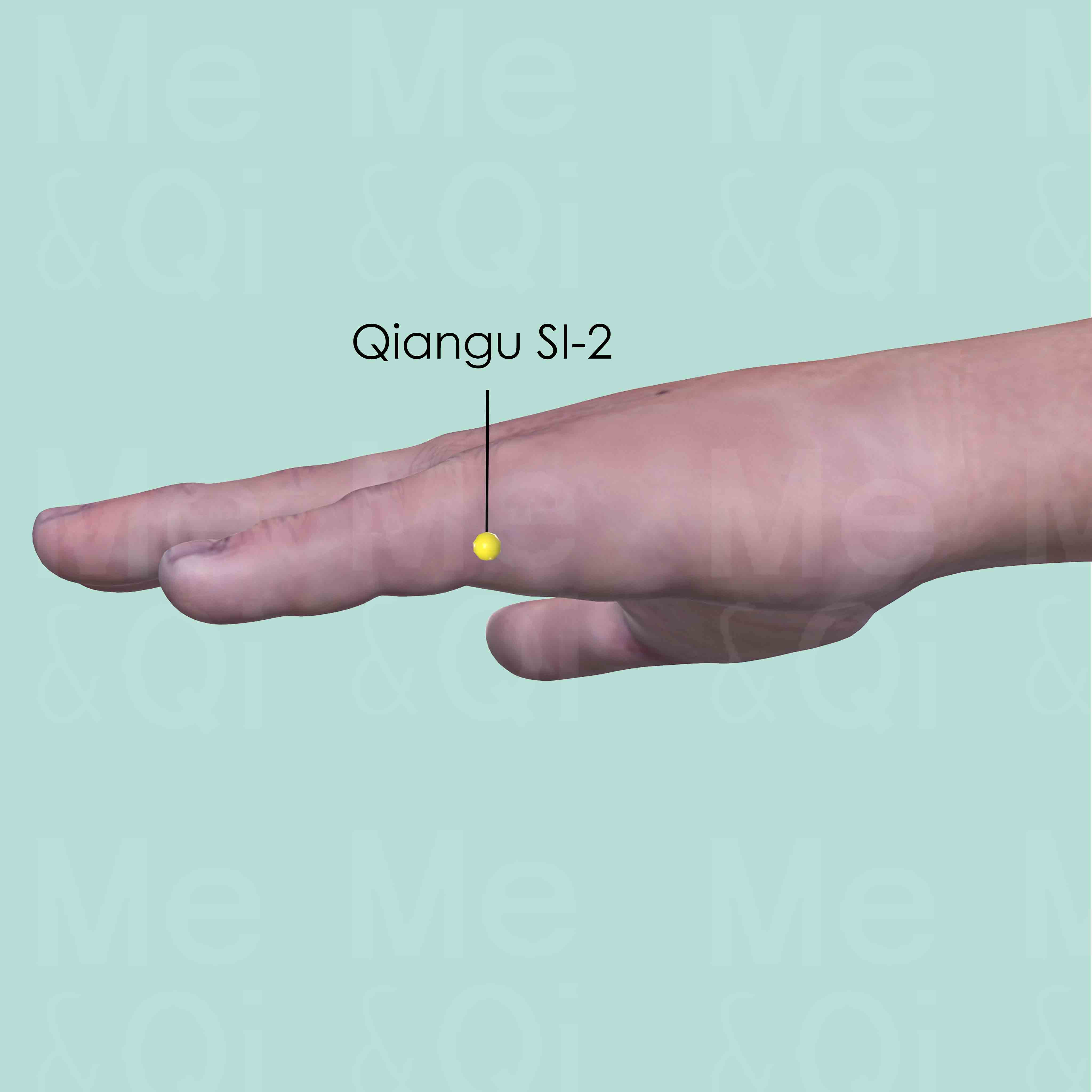
Qiangu SI-2
On the ulnar aspect of the little finger, distal to the metacarpophalangeal joint, at the junction of the shaft and the base of the proximal phalanx.
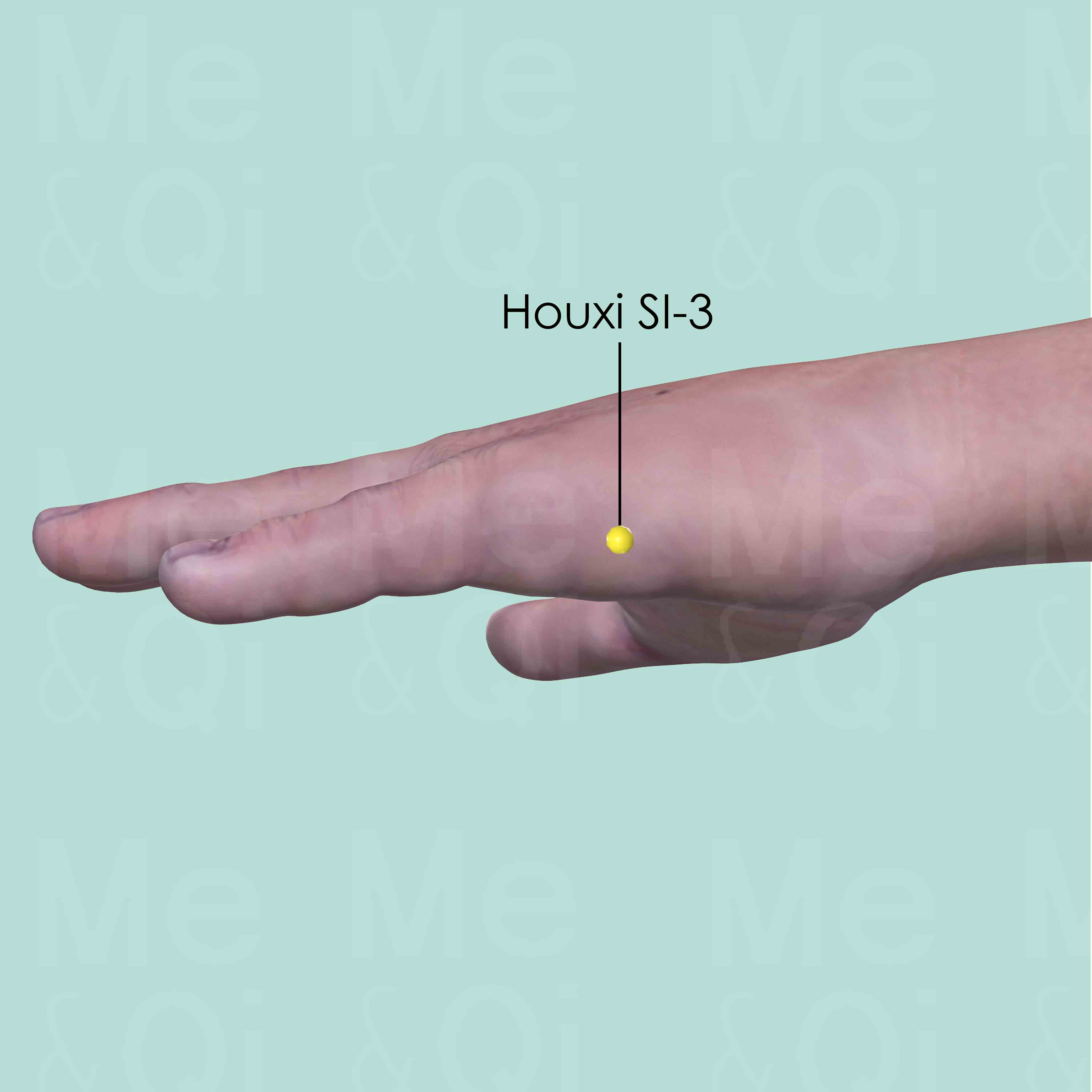
Houxi SI-3
Proximal to the head of the 5th metacarpal bone on the ulnar side, in the depression at the junction of the red and white skin.
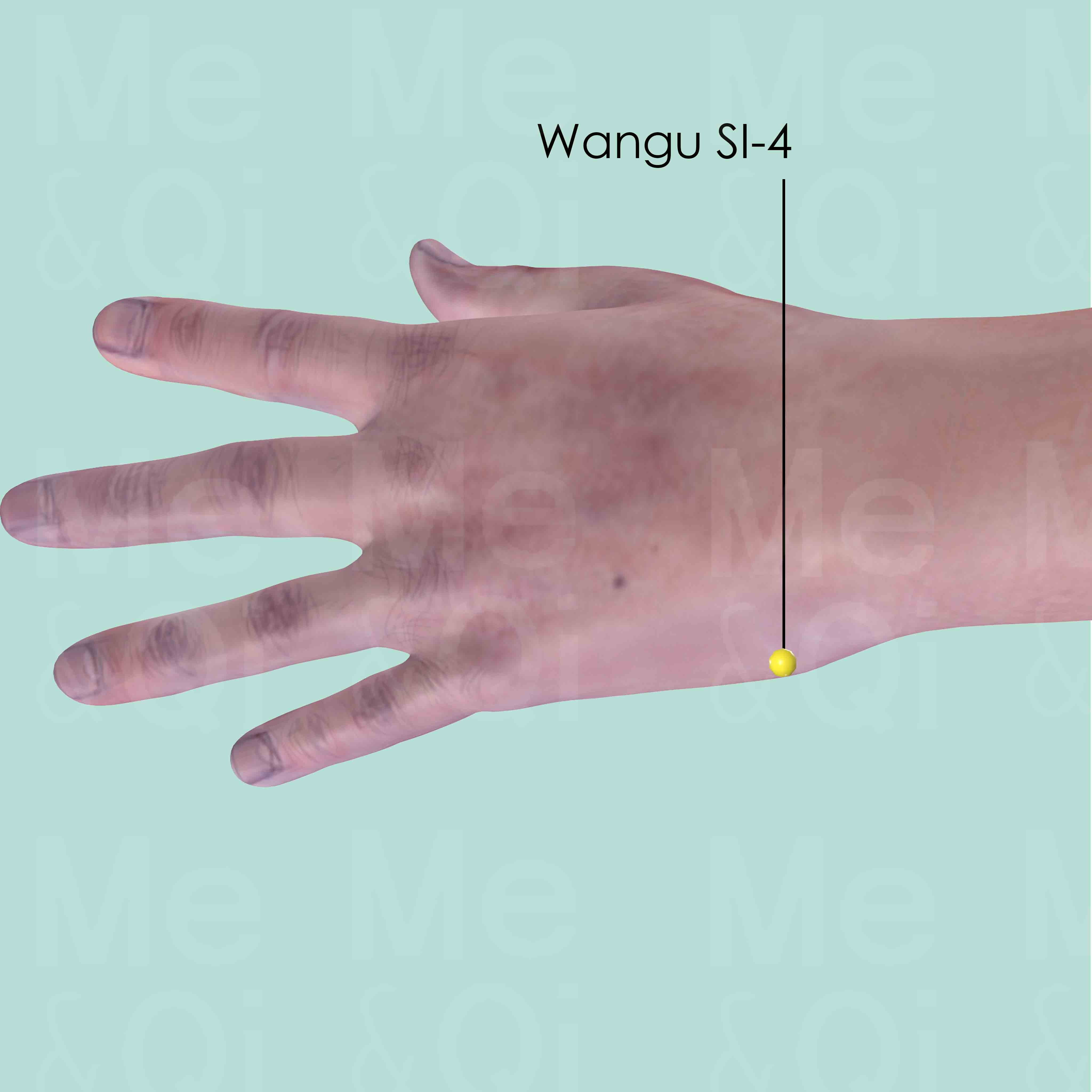
Wangu SI-4
On the ulnar side of the palm, in the depression between the base of the 5th metacarpal bone and the carpal bone.
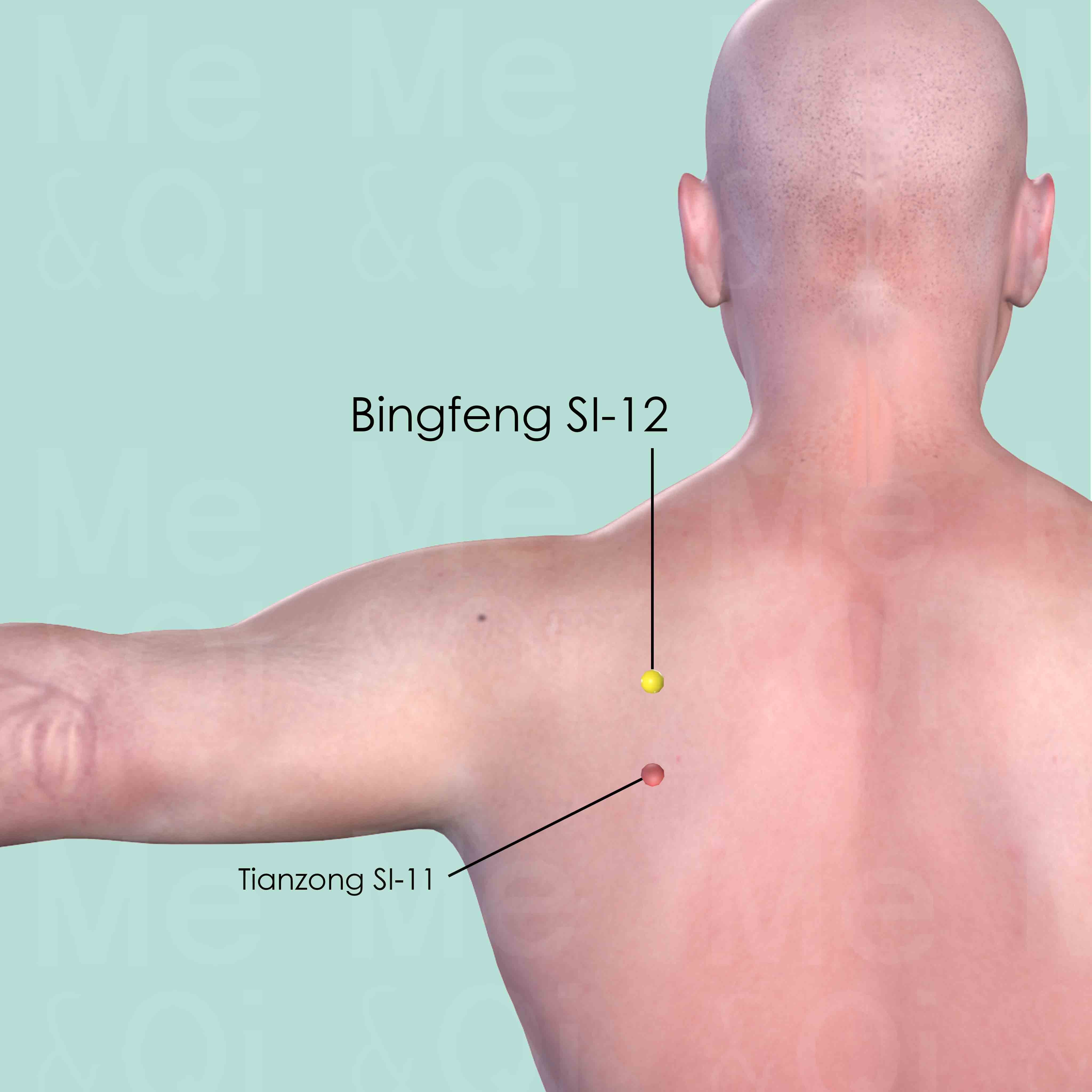
Bingfeng SI-12
In the center of the suprascapular fossa, directly above Tianzong SI-11. When the arm is lifted, the point is at the site of the depression.
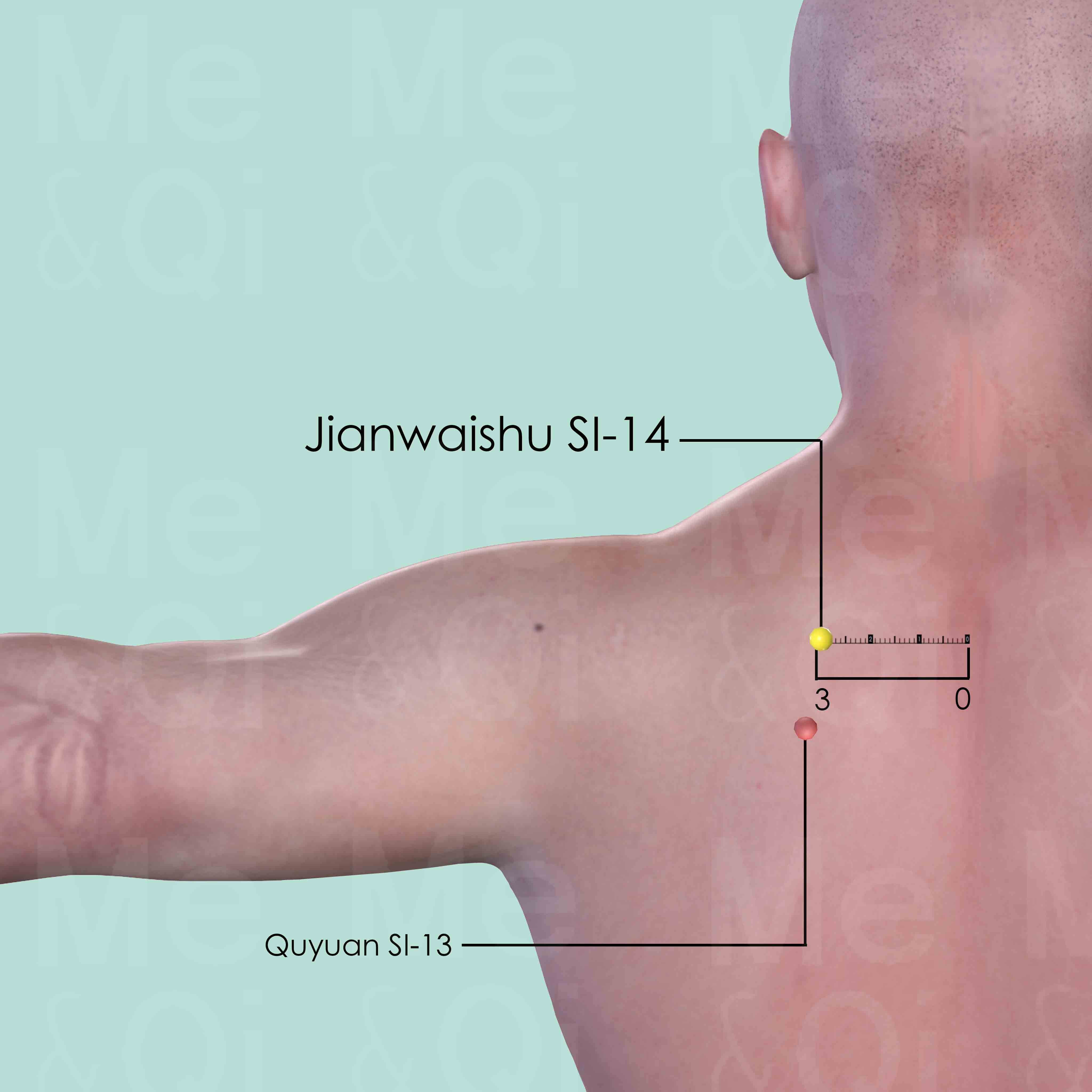
Jianwaishu SI-14
3 cun lateral to the lower border of the spinous process of the 1st thoracic verrtebra (T1), on the vertical line drawn from the levator scapulae muscle.
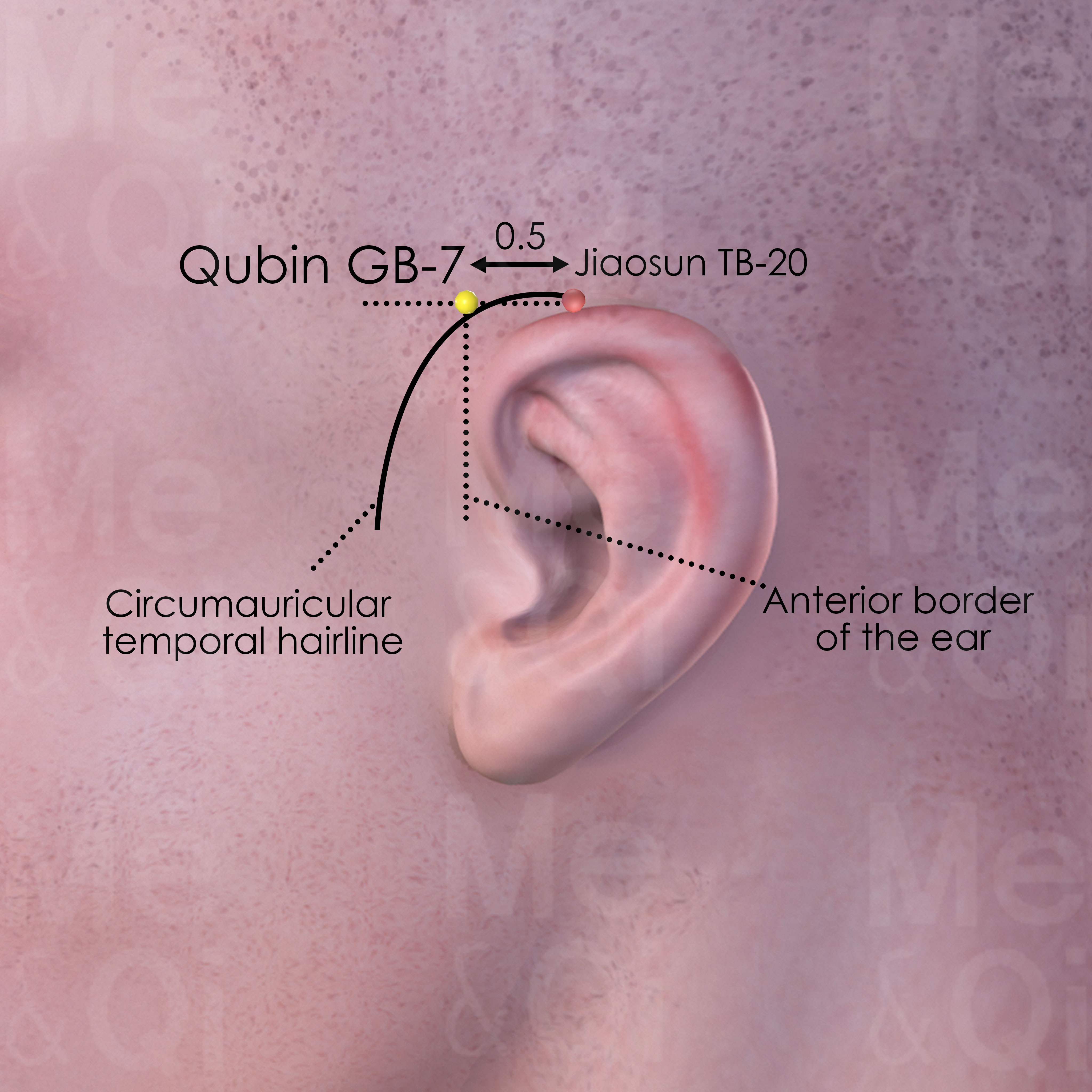
Qubin GB-7
Within the hairline anterior and superior to the auricle, about 1 finger-breadth (0.5 cun) anterior to Jiaosun TB-20 which is on the apex of the ear.
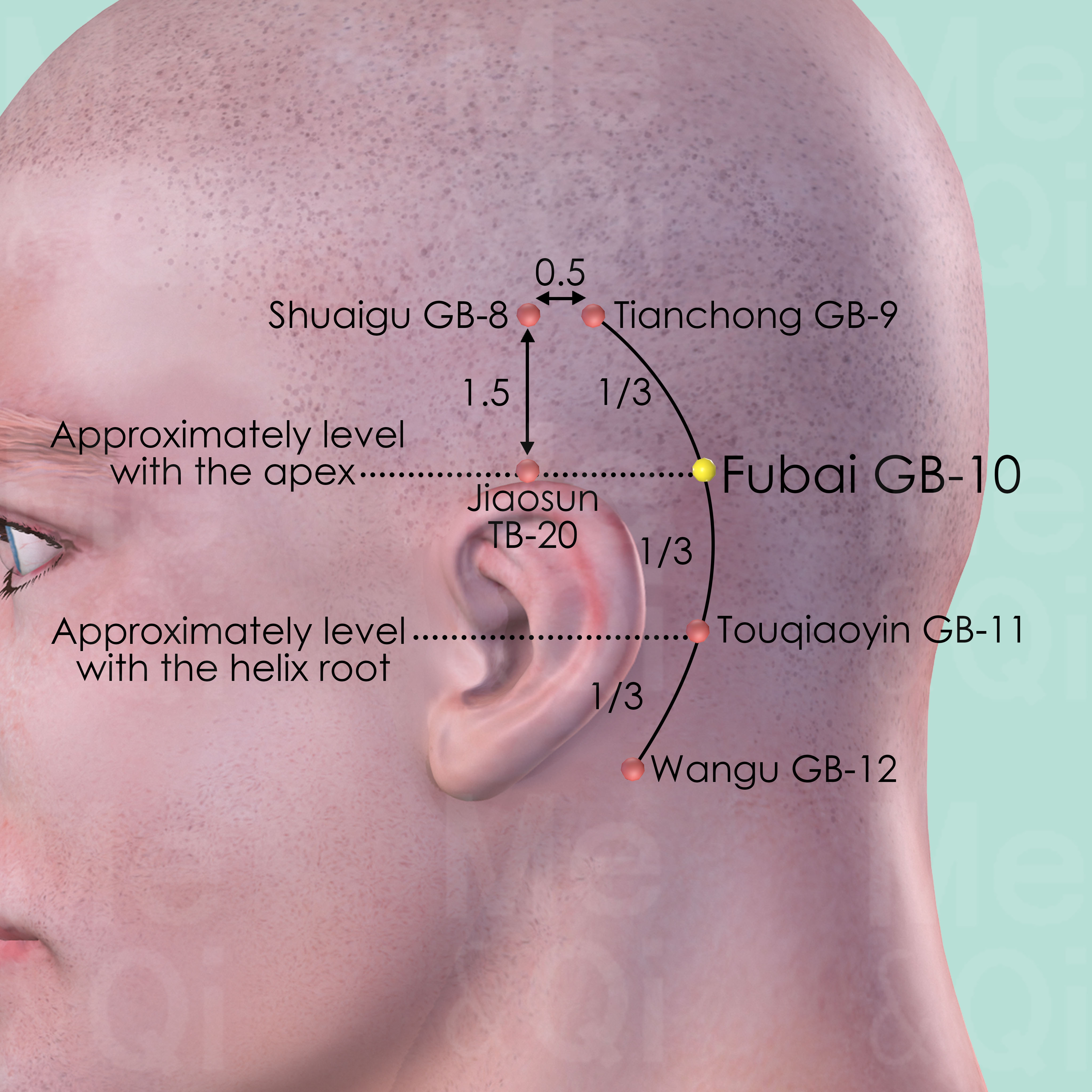
Fubai GB-10
Posterior and superior to the mastoid process, at the junction of the upper third and the two lower thirds of the curved line connecting Tianchong GB-9 and Wangu GB-12.
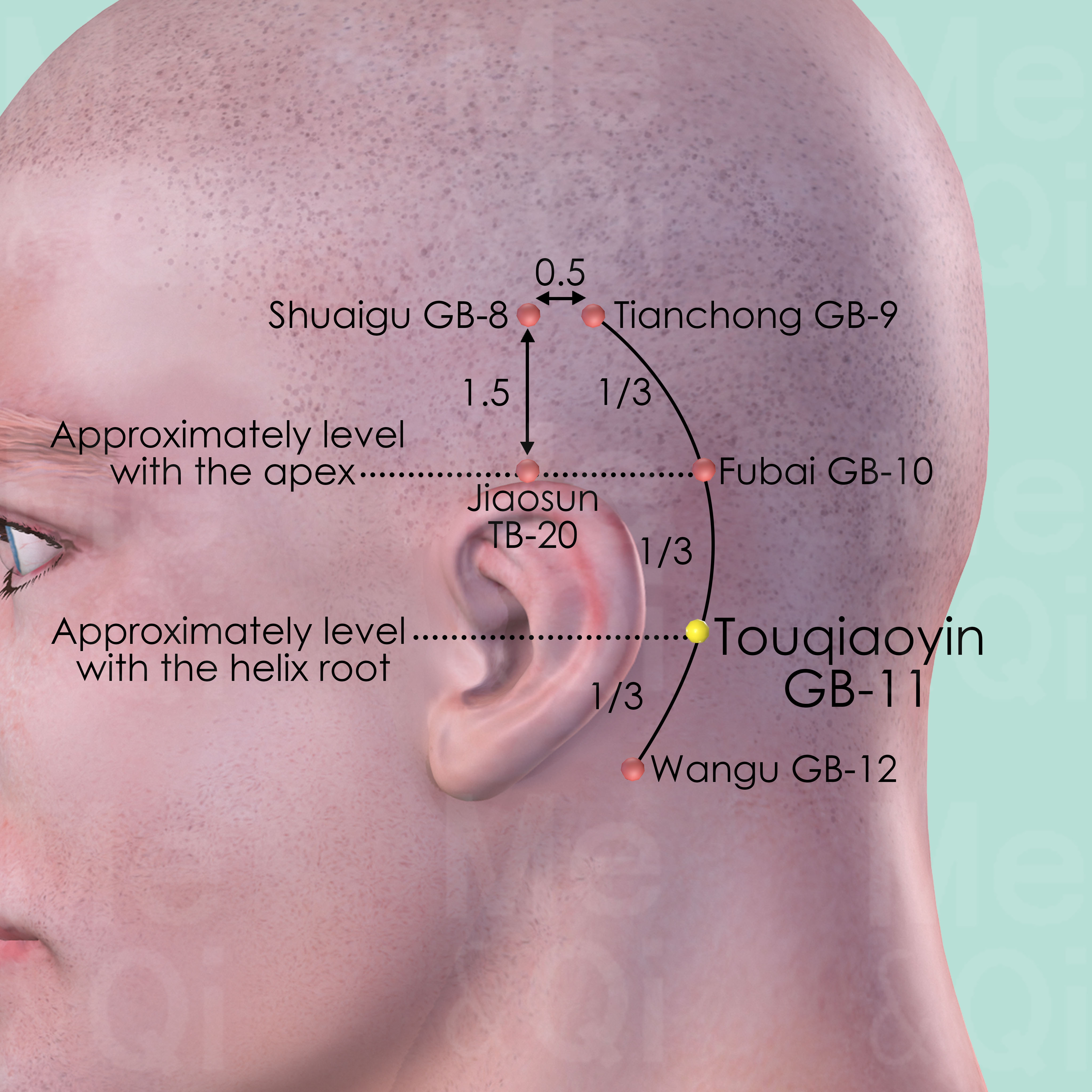
Touqiaoyin GB-11
Posterior and superior to the mastoid process, on the line connecting Tianchong GB-9, Fubai GB-10 and Wangu GB-12.
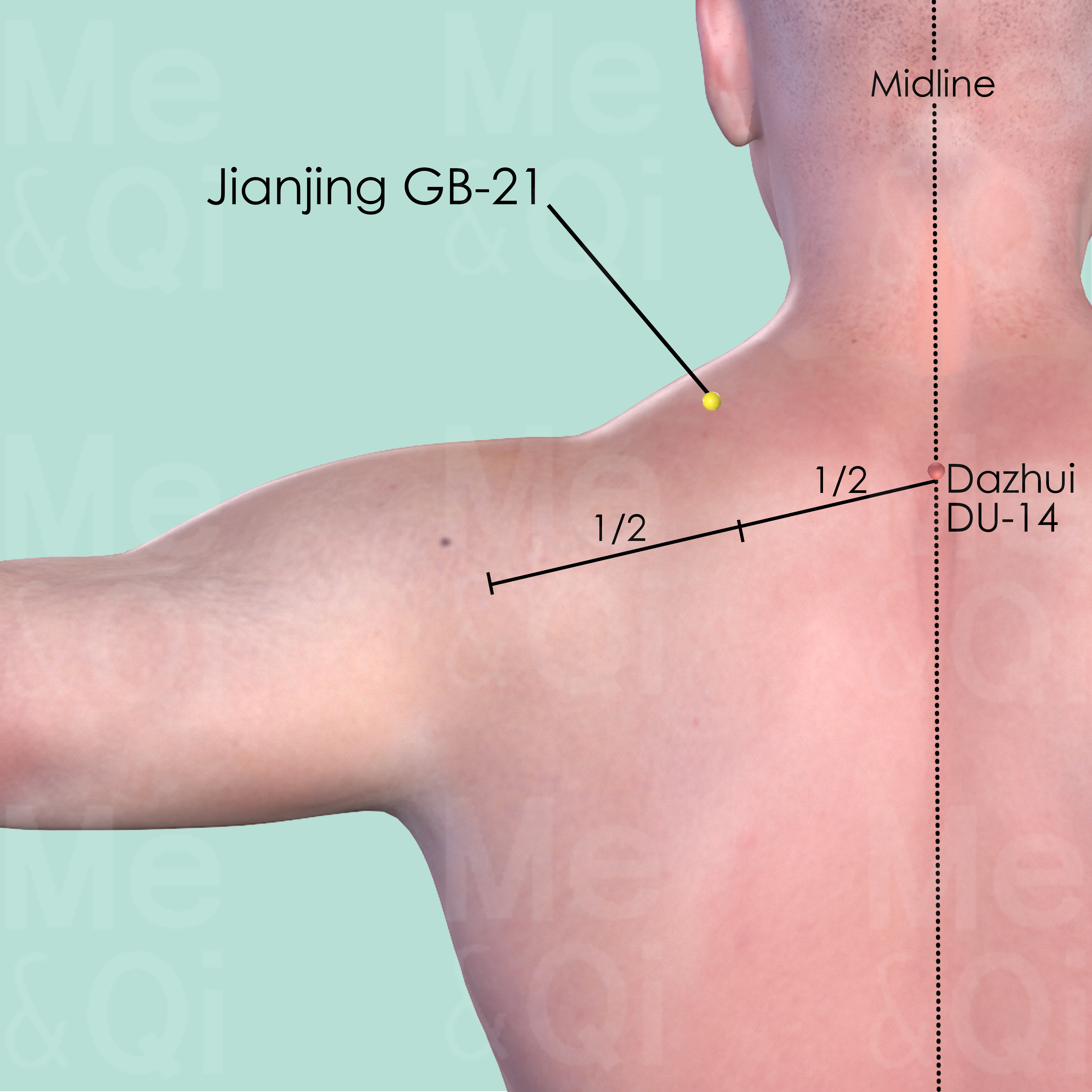
Jianjing GB-21
Midway between Dazhui DU-14 and the lateral extremity of the acromion, at the highest point of the shoulder.
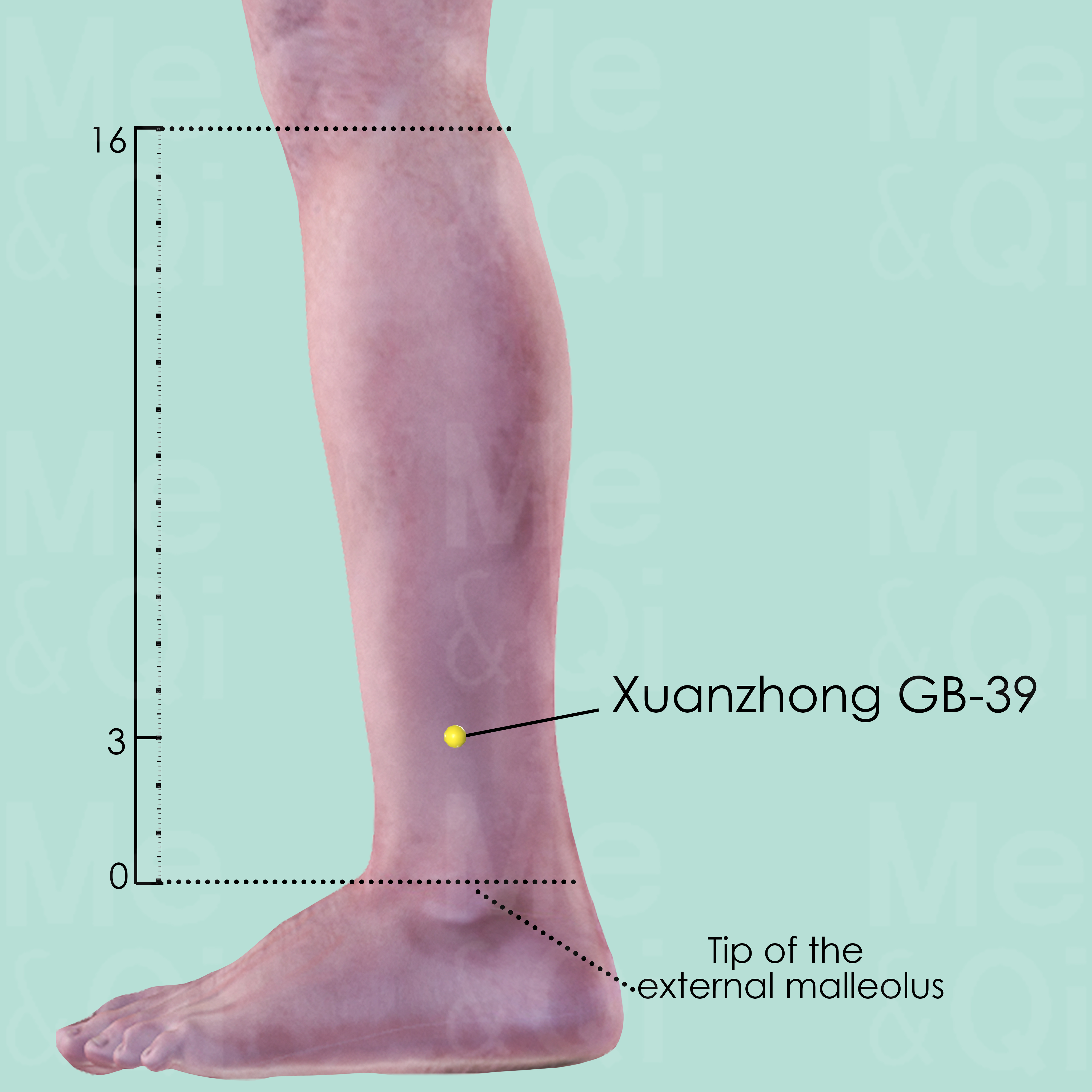
Xuanzhong GB-39
3 cun above the tip of the external malleolus, in the depression on the anterior border of the fibula.
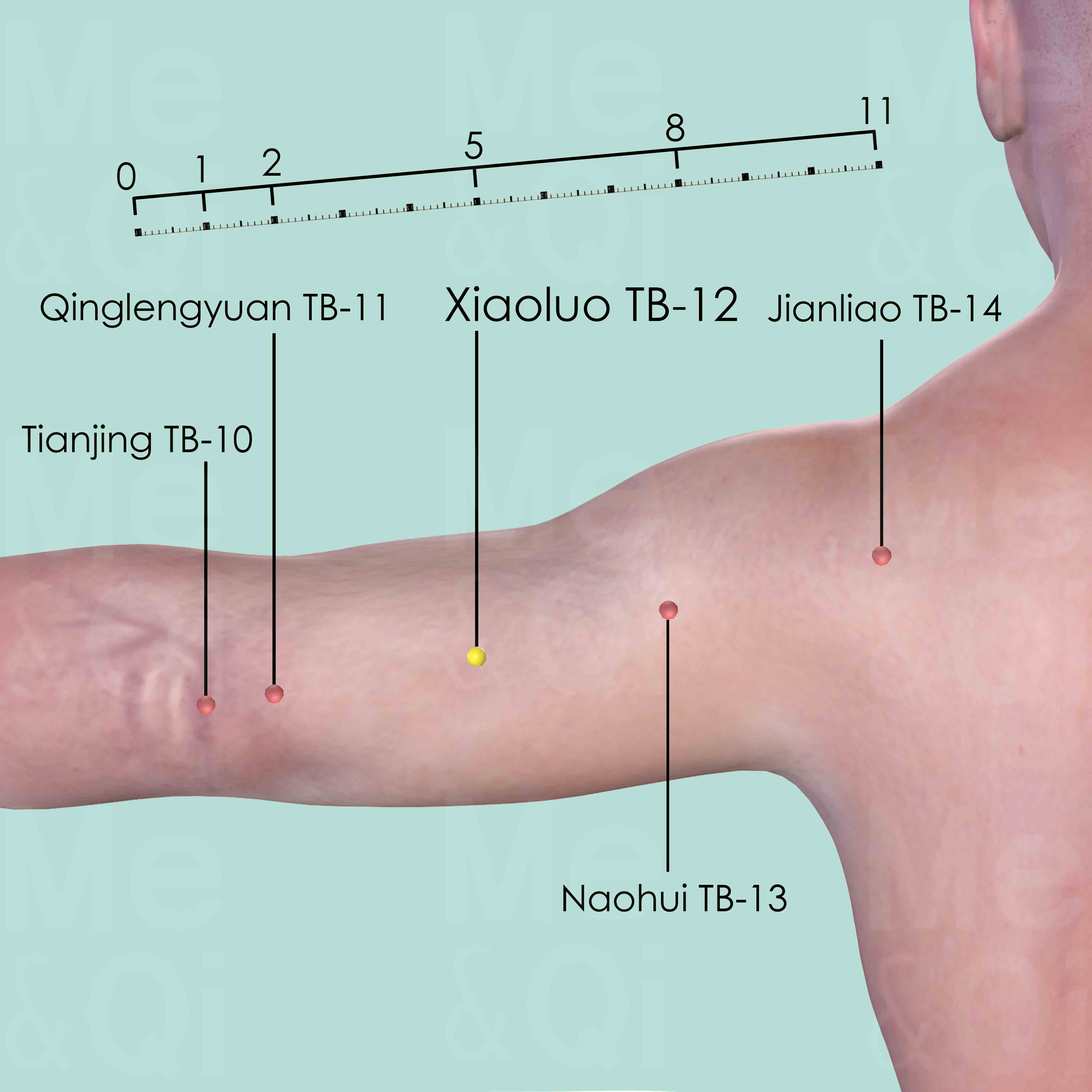
Xiaoluo TB-12
On the line joining the olecranon and Jianliao TB-14, midway between Qinglengyuan TB-11 and Naohui TB-13, 5 cun proximal to the olecranon. It is just on the lower end of bulge of the lateral head of triceps brachii when the forearm is in pronation.
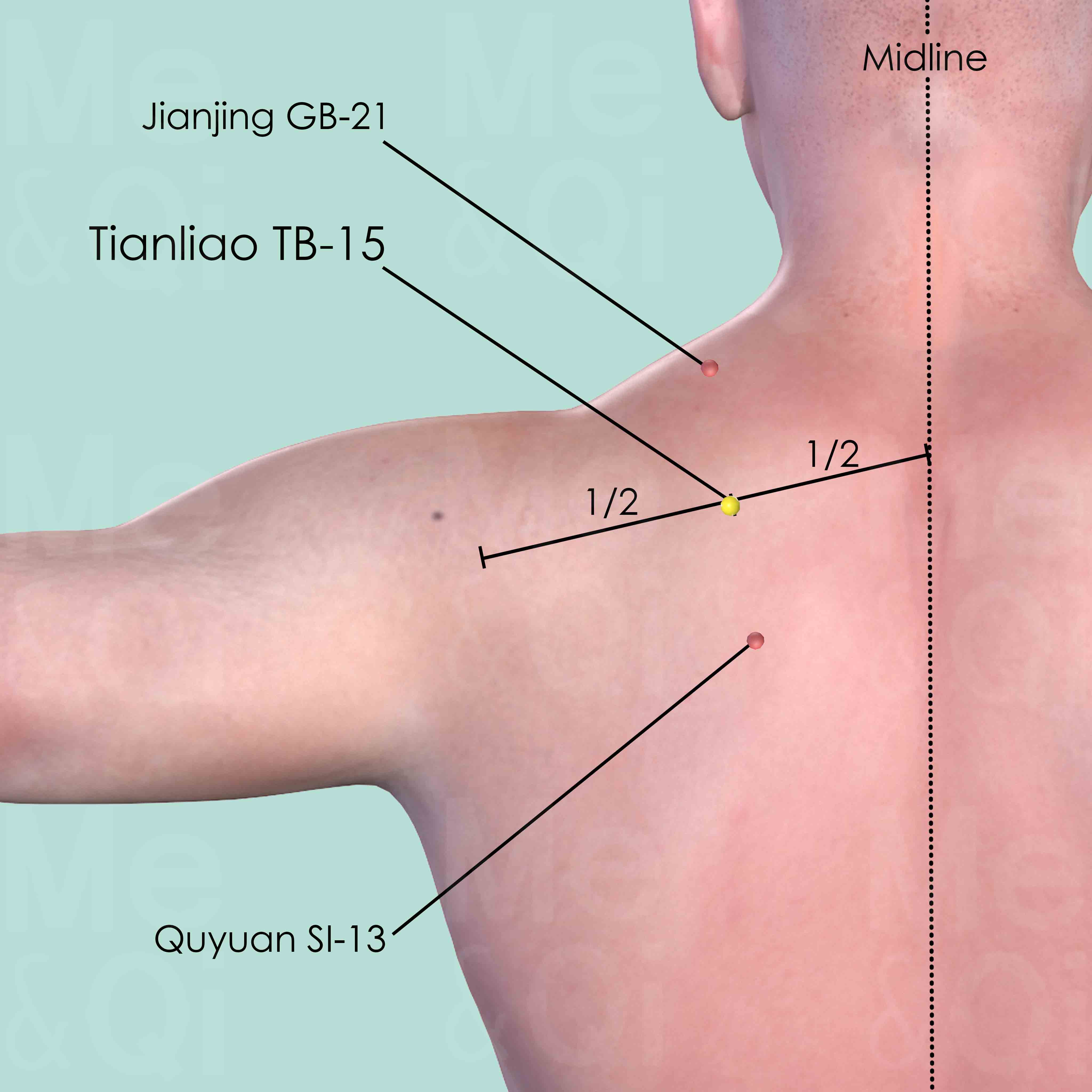
Tianliao TB-15
Midway between Jianjing GB-21 and Quyuan SI-13, on top of the superior angle of the scapula.
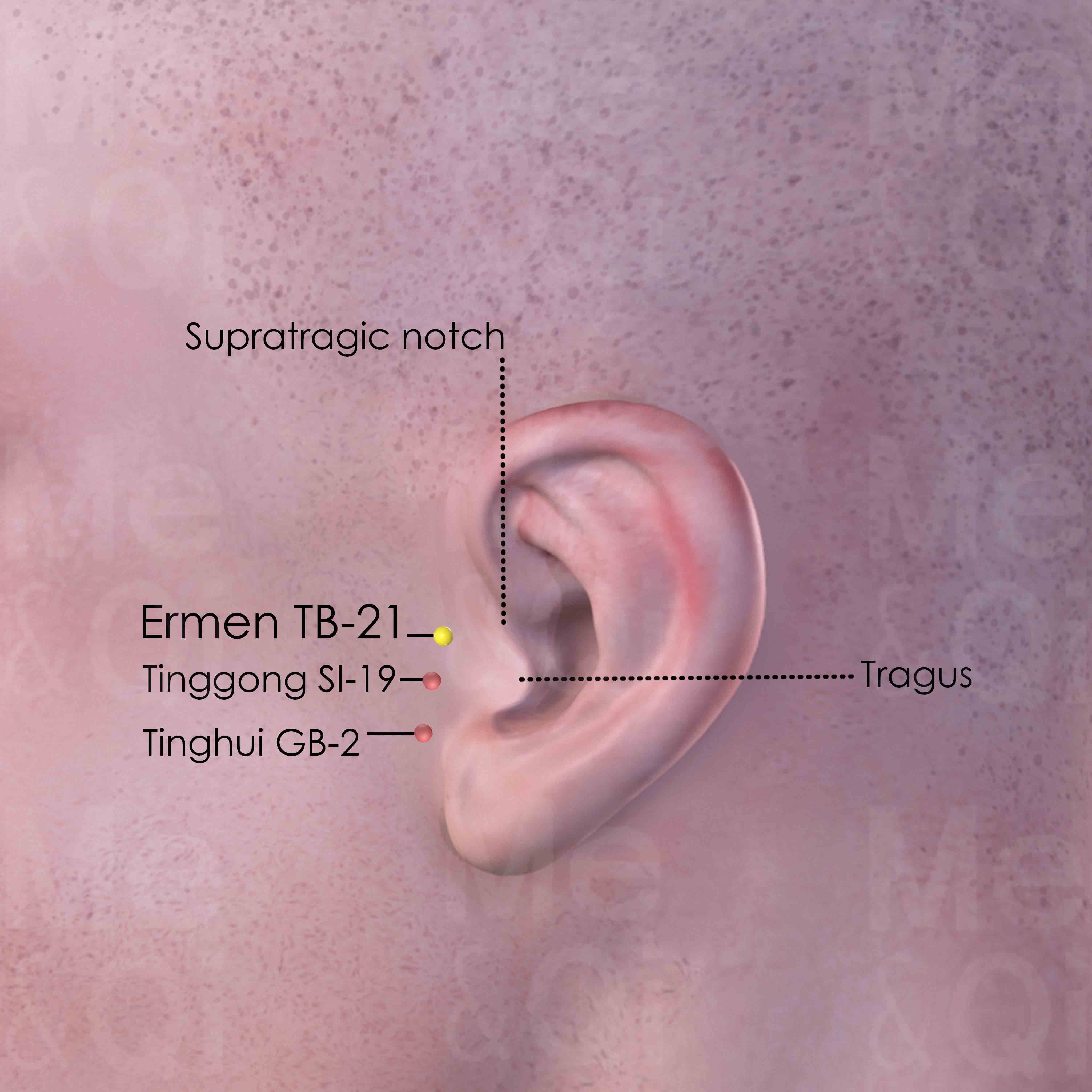
Ermen TB-21
In the depression anterior to the supratragic notch and slightly superior to the condyloid process of the mandible. The point should be located and needled with mouth open. Tinggong SI-19 and Tinghui GB-2 are located below Ermen TB-21.
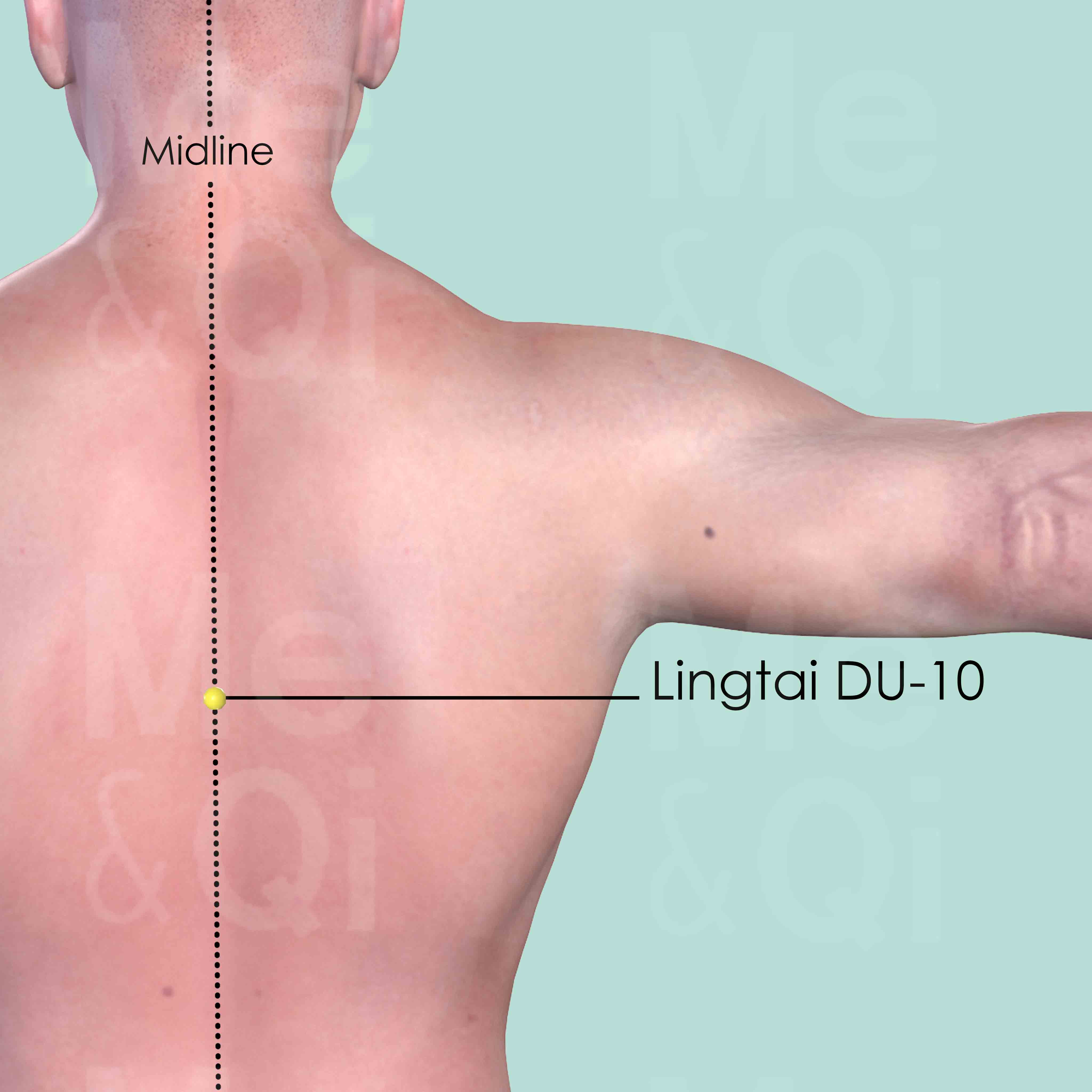
Lingtai DU-10
On the back midline, in the depression below the spinous process of the 6th thoracic vertebra (T6).
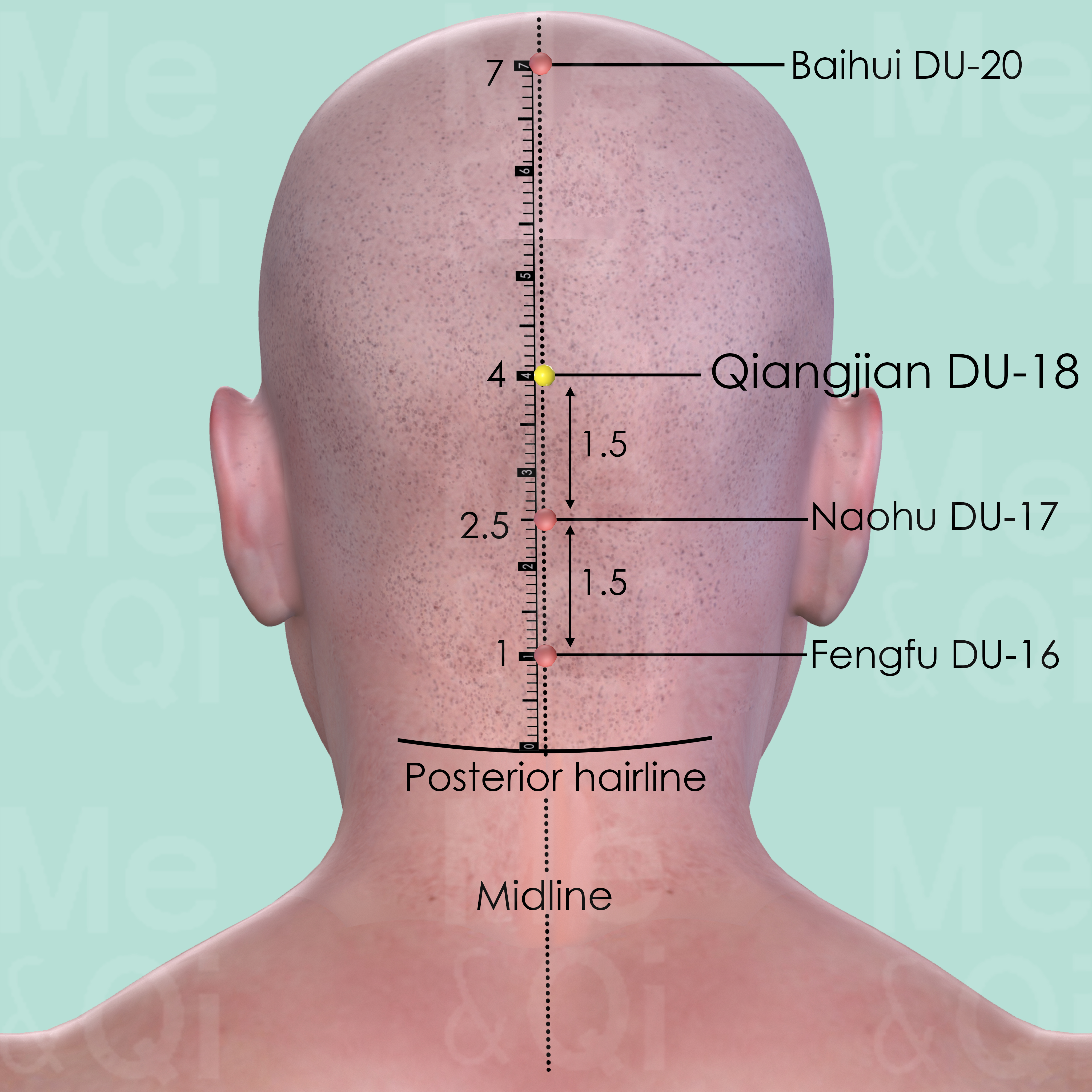
Qiangjian DU-18
On the posterior midline, 1.5 cun above Naohu DU-17, midway between Fengfu DU-16 and Baihui DU-20.
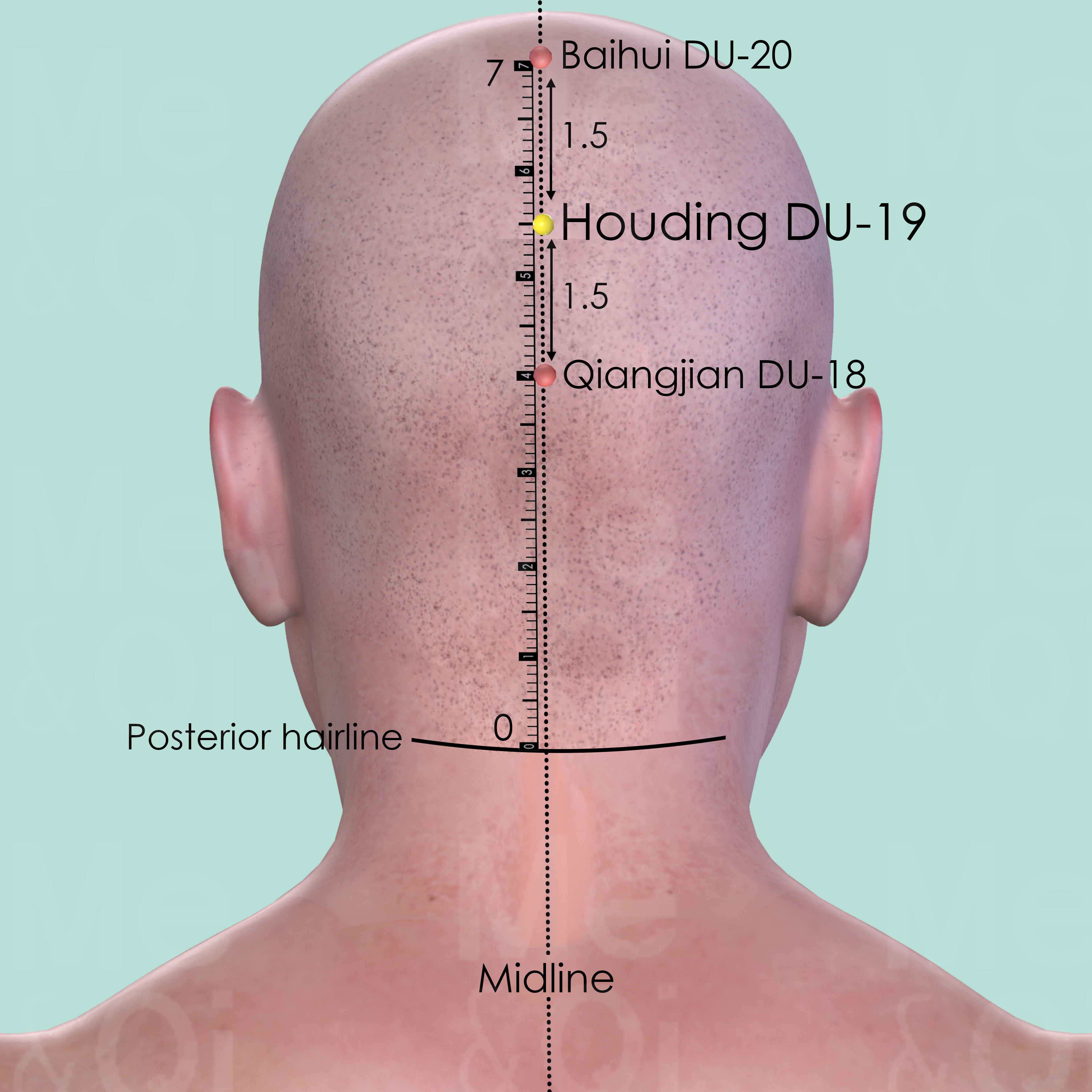
Houding DU-19
On the head midline, 1.5 cun above Qiangjian DU-18 or 1.5 cun posterior to Baihui DU-20.
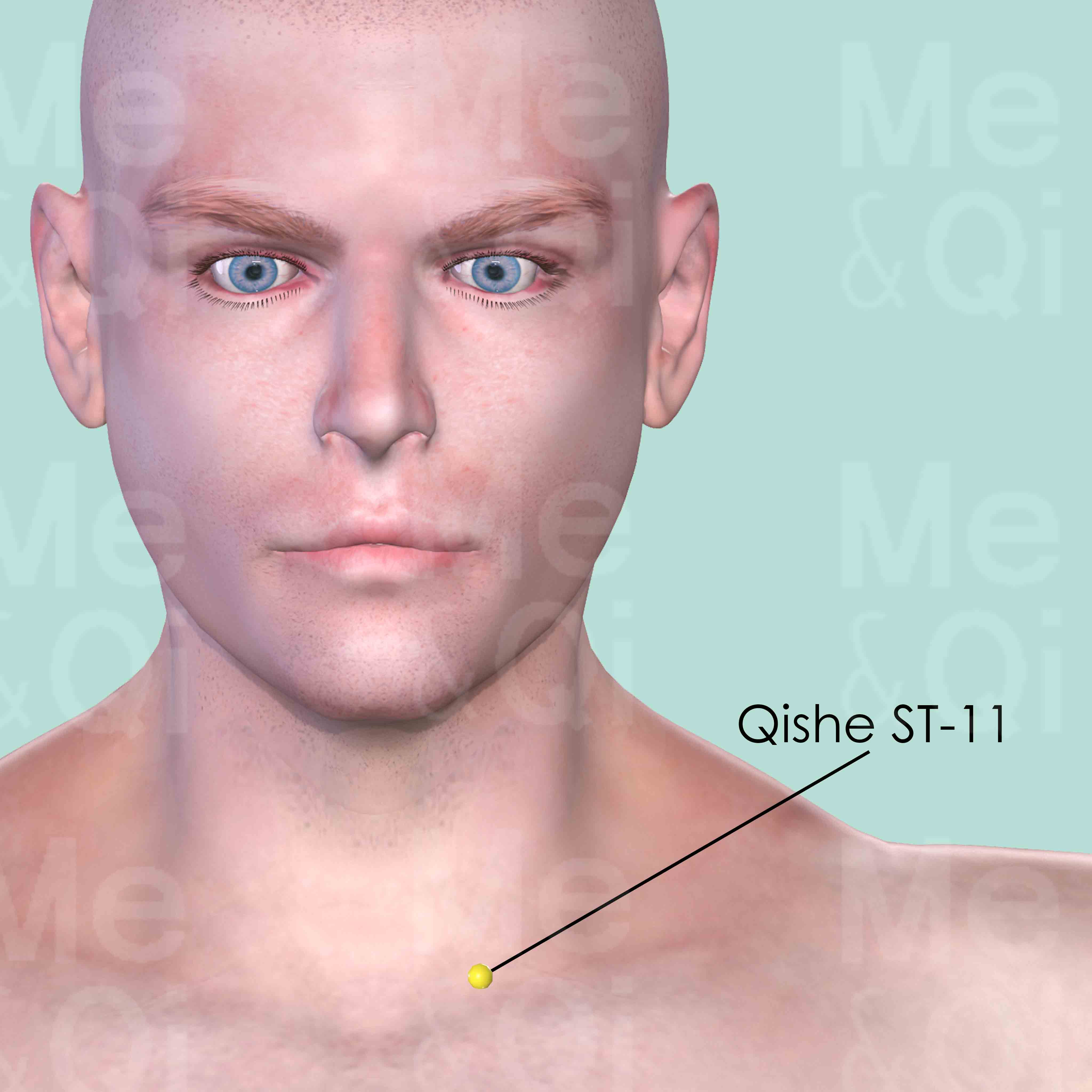
Qishe ST-11
On the upper border of the clavicle, between the tendons of the sternal and clavicular heads of the sternocleidomastoid muscle.
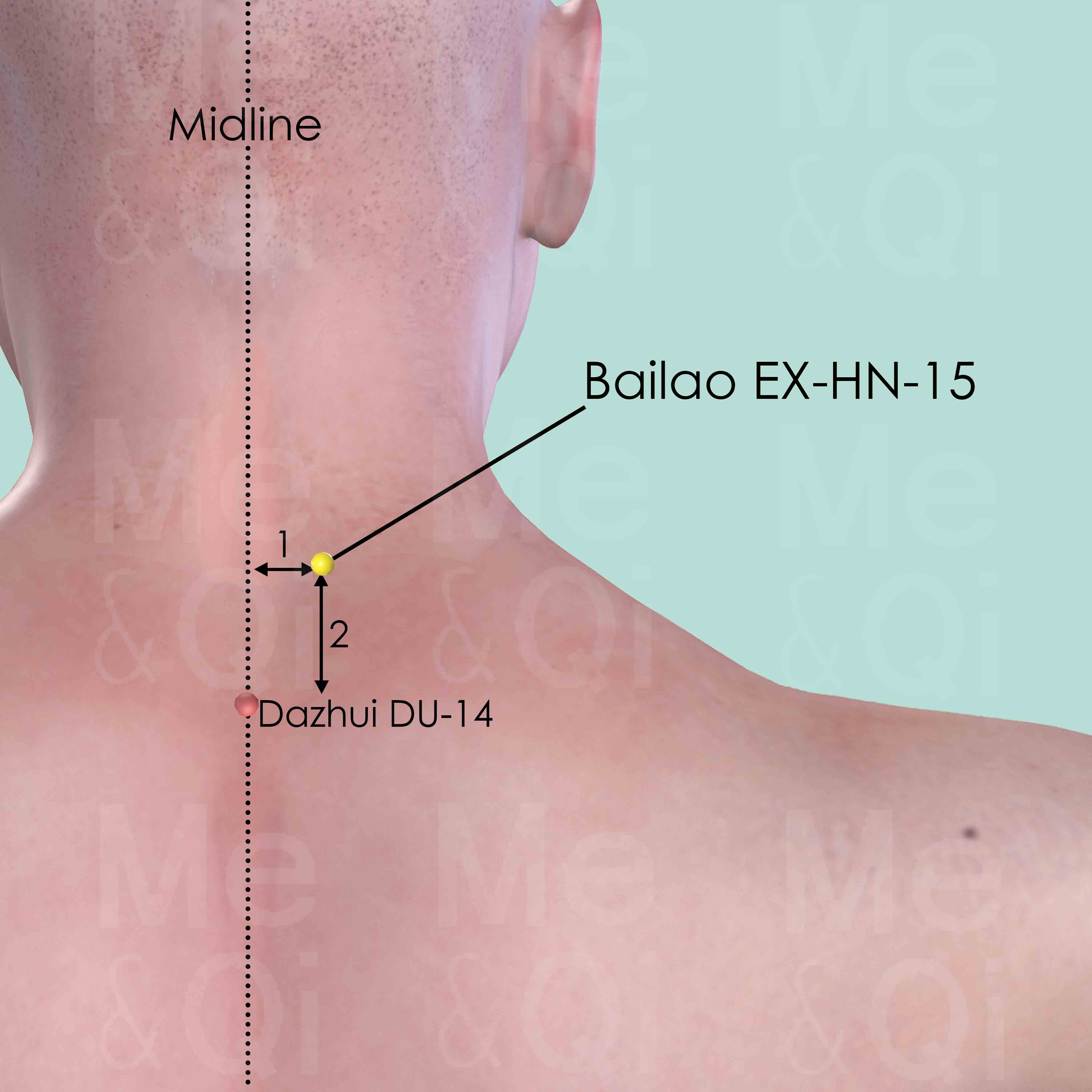
Bailao EX-HN-15
2 cun above the lower border of the spinous process of the 7th cervical vertebra (C7) and 1 cun lateral to the midline.
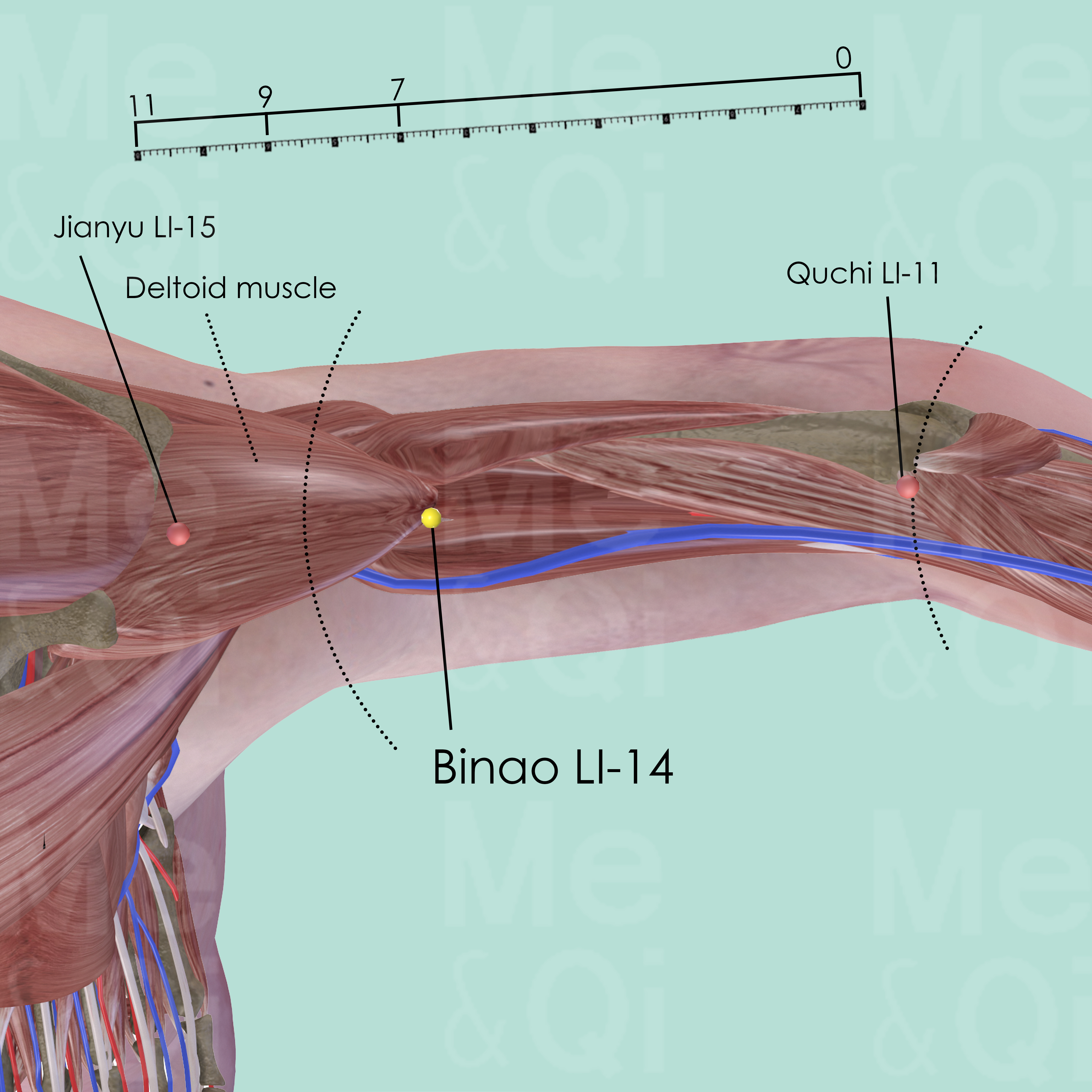
Binao LI-14
On the radial side of the humerus, superior to the lower end of deltoid muscle, on the line connecting Quchi LI-11 and Jianyu LI-15, 7 cun proximal to Quchi LI-11.
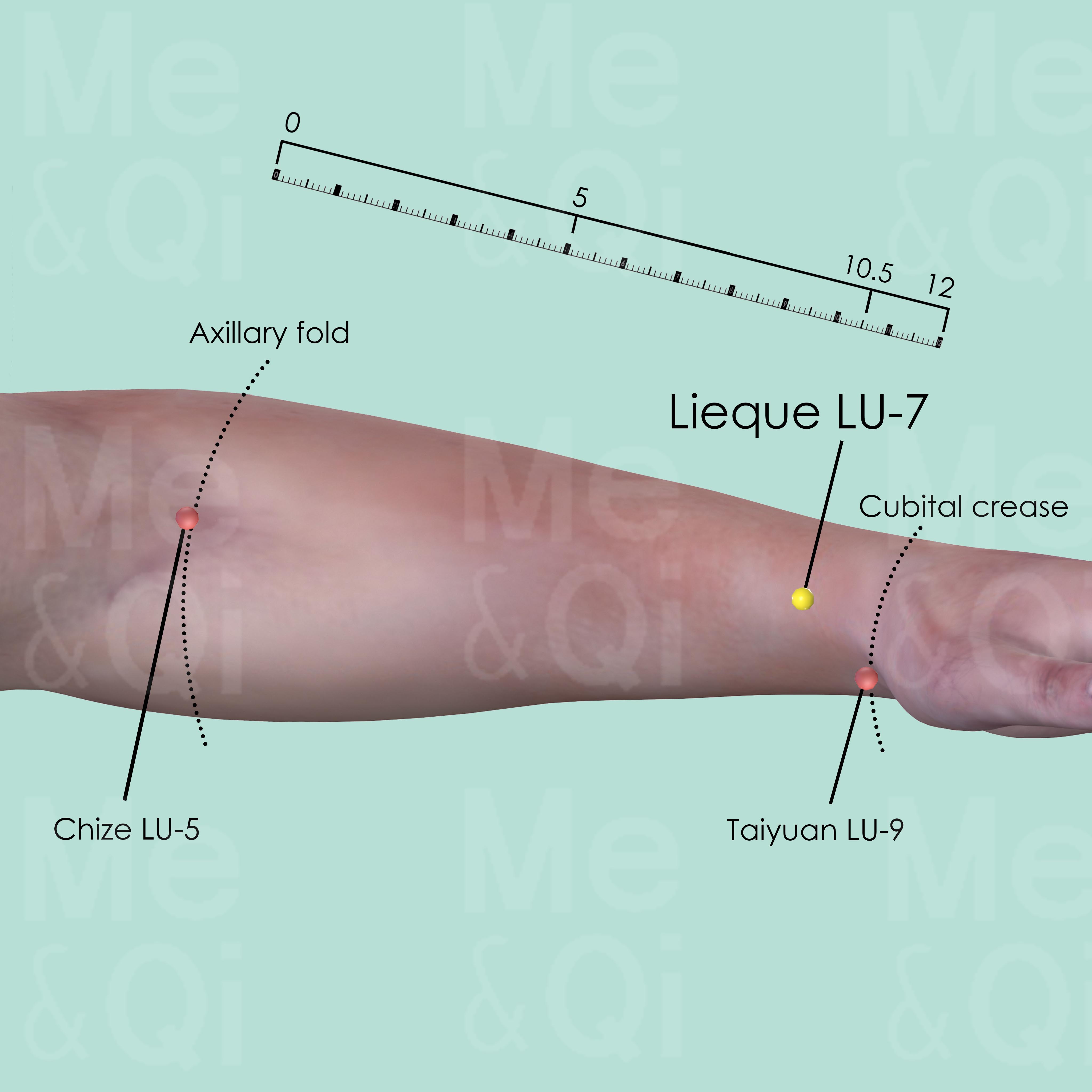
Lieque LU-7
Above the styloid process of the radius, about 1.5 cun proximal to the wrist crease (wrist joint space) in a V-shaped depression.

